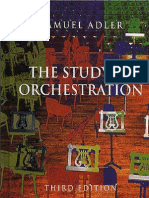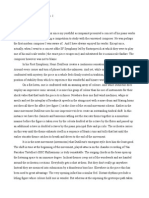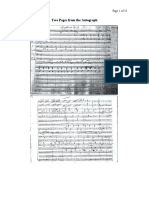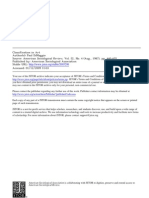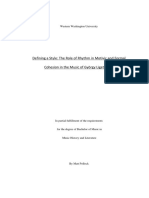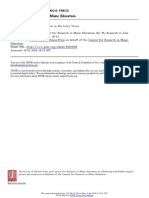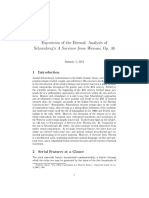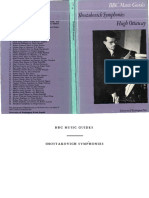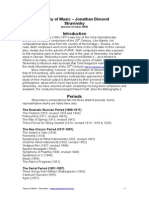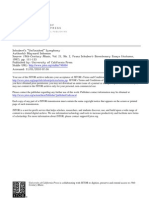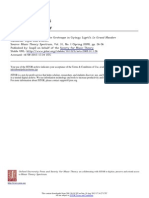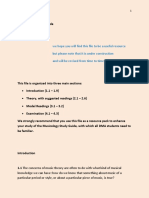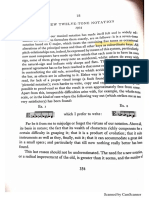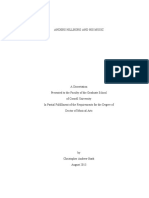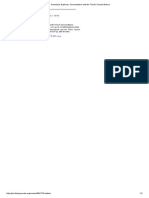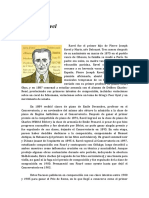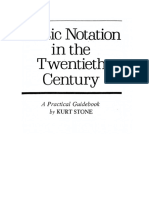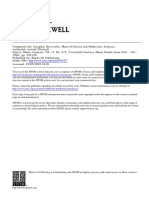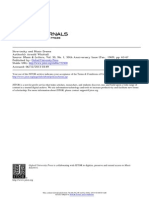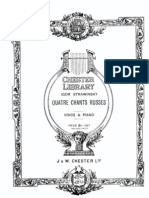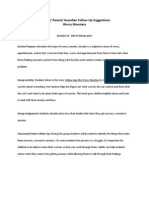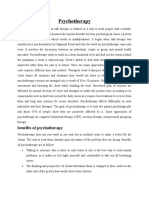Stravinsky - Van Den Toorn
Stravinsky - Van Den Toorn
Uploaded by
mao2010Copyright:
Available Formats
Stravinsky - Van Den Toorn
Stravinsky - Van Den Toorn
Uploaded by
mao2010Copyright
Available Formats
Share this document
Did you find this document useful?
Is this content inappropriate?
Copyright:
Available Formats
Stravinsky - Van Den Toorn
Stravinsky - Van Den Toorn
Uploaded by
mao2010Copyright:
Available Formats
The Twentieth Century and Beyond and
Institutions, Technology, and Economics
Stravinsky, Adorno, and the Art
of Displacement
Pieter C. van den Toorn
Much of what is characteristic of Igor Stravinskys music may be defined
rhythmically in terms of displacement, shifts in the metrical alignment of
repeated motives, themes, and chords. Stravinsky himself often began
here, in fact, not necessarily with a committed set of pitch relations, one
that is octatonic, for example, but with a phrase turned rhythmically, a
motive or chord displaced in relation to a steady metrical framework. The
many references in his published remarks to starting ideas bear this out, as
do the works and sections of works themselvesRussian, neoclassical,
and serial in origin. Even before the birth of concrete ideas, the composer
would set himself in motion by relating intervals rhythmically, improvising
on a set of rhythmic units. This initial exploration, he later confessed,
was always conducted at the piano.1
Adorno began here, too. Targeted in his celebrated indictment of
Stravinskys music are, above all, the composers rhythmic practices, the
frequent displacement of accents, and the disruptive effect of displacement on the listener. The absence of expressive timing is bemoaned, the
lack of any subjectively expressive fluctuation of the beat.2 And instead
of the developmental style of the classical tradition (as defined by Arnold
Schoenberg, Adornos point of departure musically and music-analytically), the repetition in Stravinskys music was relentless and literal. No
development could be inferred, no elaboration of motives or motiveforms.3 So paradoxical in a music that could seem outwardly vital from a
rhythmic standpoint, the overall effect was often one of standstill or stasis,
an invention incapable of any kind of forward motion.4 The repetition
constantly presents the same thing as though it were something different,
Adorno complained. Farcical and clownish, it has the effect of putting on
airs, of straining without anything really happening.5
Such characterizations form the liveliest part of Adornos critique.
Descriptions of one kind or another, they address the psychological effect
of Stravinskys music. At the same time, however, they are often incomplete and fragmentary, with the task of piecing them together left to the
doi:10.1093/musqtl/gdh017
87:468509
Oxford University Press 2005. All rights reserved. For permissions, please e-mail:
journals.permissions@oupjournals.org.
Stravinsky, Adorno, and the Art of Displacement
469
reader. Adornos approach is unsystematic to the point of being unintelligible
(anti-systematic, as some have suggested more sympathetically),6 with
the analytical descriptions themselves hemmed in by sweeping philosophical
and sociological conjectures often no less fragmentary in character. The
stream of consciousness can be explained by the dialectical processes at
work, but only up to a point, and the suggestion of many of Adornos
adherents to the effect that the critic-philosopher fetishized this particular
aspect of the process (its lack of finality) can seem real enough.7 Adorno
acknowledged the constellation-like effect of his thought and prose,8
but the results can often seem like waywardness all the same, a poetic
obscurity substituting for the more determined effort to address head-on
the complexity of the issues raised.
Indeed, there are problems with the analytical description as well. As
Max Paddison has observed, a strange disparity exists between the
sophistication and radicality of [Adornos] aesthetics and sociology on the
one hand and the lack of sophistication and traditional character of his
music-analytical method on the other.9 Actually, it is not so much the
thematic-motivic model of analysis inherited from Schoenberg that lacks
sophistication as it is its application (or lack of application). Missing not
only in Adornos Philosophy of Modern Music10 but also in a later essay on
Stravinsky11 are definitions of every conceivable kind (elementary ones
for terms such as accent, for example), identifications of passages and
sections of works cited, and the analytical detail that must necessarily
qualify generalization if generalization is not to lapse into polemic. The
need for concrete detailfor the grounding of abstract terms and concepts in the structure of the music itselfis acknowledged early on in
the Philosophy of Modern Music,12 but is never allowed to materialize in the
form of an effective supplement.
Yet the bits and pieces of Adornos description are worth pursuing all
the same. And they are so more for the musical illumination than for the
larger philosophical and sociological ideas to which they are attached (and
from which, as Adorno and his adherents have insisted, they not only
derive their meaning but are inseparable).13 They are worth pursuing for
the musical and music-historical sense that can be made of the juxtaposition of Schoenberg and Stravinsky, the juxtaposition of the classical or
homophonic style as defined by Schoenberg (the style of developing
variation)14 and Stravinskys processes of displacement. Where the construction of thematic material is concerned, the invention and use of such
material, these two worlds can indeed seem to stand apart in ways that are
immediately identifying, ways that can enliven experience and its reflection.
Confronted in Adornos Philosophy, and in the later Stravinsky essay
as well, is that single dimension in Stravinskys music that has seemed
470 The Musical Quarterly
most to identify it in the ears and eyes of the listening public, namely that
of rhythm and meter. The features that preoccupy Adorno are those that
tend to stand out, in fact, perhaps in works of the early Russian period
above all: the mechanical nature of the beat and its transmission, the
displacement of accents, the rigidity of the juxtapositions, and the seemingly unvaried and relentless nature of the repetition. Touching on matters
that pertain to the listeners immediate response to Stravinskys music,
Adornos concerns can be made to relate to wider and more tangible ones,
to the listeners entrainment of meter, for example, to the role of expectation in music, and to the way in which emotion (pleasureful or not) is
aroused. In Leonard Meyers now classic formulation of emotion and
meaning in the Western art tradition, emotions are stirred when implications or tendencies are inhibited or arrested, when established norms are
broken.15 And the way in which expectations of metrical parallelism are
thwarted by displacement in Stravinskys music, with the meter often disrupted as a result, figures as an instance of this type of interaction. Indeed,
there is little reason why Adornos critique should not be scrutinized from
perspectives of this kind, be made to relate to the world of music theory
and analysis and its ties to issues of perception and cognition.
Much of this can be pursued irrespective not only of Adornos
philosophical ideas, but of the still larger framework (mainly Hegelian and
Marxist) to which those ideas are attached. Indeed, it can be pursued
irrespective of Adornos critical verdict. The latter need not be accepted
in order for the analytical description, harnessed as a means of support, to
be appreciated. Our understanding can be reasonably sympathetic, in fact,
without in any way accepting the no of Adornos account. Indeed, as
Virgil Thomson remarked some time ago, where matters of musical understanding and criticism are concerned, the actual opinions of critics need
not concern us unduly.16 What counts is the musical understanding that
is brought to bear, the features that are noticed, described, and commented upon in one way or another. The Schoenbergian model of the
classical style can serve as a useful foil for Stravinskys music regardless of
the larger and less tangible philosophical and sociopolitical meanings to
which, in Adornos account, that model is attached. On the more speculative
side of Adornos argument, too, many of the negative images can be
detached and replaced by positive ones.
With this in mind we shall first be seeking to retrace the steps of
Adornos critique, supplementing the analytical description with the detail
and exemplification often missing in the Philosophy. Following this, a detailed
definition of metrical displacement and its implications in Stravinskys music
will be attempted, followed in turn by a number of rebuttals of Adornos argument. Conclusions will then lead to a somewhat less strident, less polarized
Stravinsky, Adorno, and the Art of Displacement
471
view of the Schoenberg-Stravinsky divide, one in which the great variety of
displacement in Stravinskys music can imply processes and psychologies that
are not always at odds with those of more traditional tonal contexts.
Adorno Interpreted
Adorno is struck above all by the concentration of accents and time relationships in Stravinskys music. The most elementary principle of this
concentration is displacement: melodic fragments and motives are
constructed in such a way that if they immediately reappear, the accents
on their own accord fall upon notes other than they had upon their first
appearance.17 Because of their irregularity, the shifting accents can
appear to be the result of a game of chance. They can seem to be under
a spell.18 The game they play is an arbitrary one, according to Adorno,
one whose rules lie beyond the control of the listener. And the arbitrariness
of the game precludes participation and engagement on the part of the
performer or listener. The listeners role is reduced to that of a spectator.
Stravinskys displaced accents resist assimilation. They cannot be
anticipated, and so appear as shock effects.19 And while shock is
accorded a legitimate place in the reception of much contemporary music
(in that of Schoenbergs atonal and twelve-tone music, above all, where
Adorno identifies it with a sudden recognition of the horrors of the
modern world), its effect in Stravinskys music is viewed as debilitating.
Deprived of the ability to anticipate, listeners cannot absorb the irregularly shifting accents of displacement. Shock overwhelms them, and
they lose their self-control. In Stravinsky, there is neither the anticipation of anxiety nor the resisting ego; it is rather simply assumed that shock
cannot be appropriated by the individual for himself. The musical subject
makes no attempt to assert itself, and contents itself with the reflective
absorption of the blows. The subject behaves literally like a critically
injured victim of an accident which he cannot absorb and which, therefore, he repeats in the hopeless tension of dreams.20
Reference here and elsewhere in Adornos account to a musical
subject implies dramatization. The musical subject rather than the
listener falls victim to Stravinskys arbitrarily displaced accents. (The
listener is seldom mentioned in Adornos account, in fact, although
listener and subject are clearly interchangeable in this regard, with
each viewed as the victim of the same set of musical circumstances.)
Thus, the music lacks an overriding pattern according to which the
irregularly shifting accents could be organized. In Adornos descriptions,
the listeners inability to organize these accents becomes the subjects
472 The Musical Quarterly
inability. Just as the listener loses his or her metrical bearings, so, too, the
subject cannot heroically reshape the displaced accents in his or her
image: the accents are experienced as convulsive blows and shocks.21
And although the specifics of this listener-to-subject translation are omitted from the record, they are an integral part of the equation. Without
them, Adornos characterizations would make little sense.
Central to Adornos argument is the idea of a balance in music of the
highest quality, a balance between the four musical dimensions of melody,
harmony, rhythm, and form. In Stravinskys music, this is overturned by
an emphasis on rhythm and, more specifically, on displacement and its
effect of shock. That great music could consist of such an ideal
equilibriumone good for all seasons, as it wereis an idea traceable to
Schoenberg (Adornos likely source, in any case),22 although it appears in
other guises early in the twentieth century as well. Schoenberg wrote of
the need for music to develop consistently and equally in all directions.23 Not only were these directions inseparable, but an emphasis on
one could come only at the expense of the others. Ideas similar to these
were expressed in a number of critical surveys during the 1920s and 1930s,
including Cecil Grays A Survey of Contemporary Music (1924). There,
each parameter is viewed similarly as being at its highest when all are in
complete equilibrium, when one does not predominate over the others.24
Music of the greatest masters is neither harmonic, rhythmic, nor
melodic, according to Gray; it is all and it is none.25 Adornos version of
this ideal runs as follows:
Stravinskys admirers have grown accustomed to declaring him a rhythmist
and testifying that he has restored the rhythmic dimension of music
which had been overgrown by melodic-harmonic thinkingagain to
honor. . . . Rhythmic structure is, to be sure, blatantly prominent, but this is
achieved at the expense of all the other aspects of rhythmic
organization. . . . Rhythm is underscored, but it is split off from content, it
results not in more, but rather in less rhythm than in compositions in
which there is no fetish made of rhythm.26
Melody is the first casualty of these imbalances. Instead of a formation
of shapes and contours, the melodies subjected to displacement in
Stravinskys music are truncated, primitivistic patterns.27 No independent melodic life may be inferred from these patterns, no structure to
speak of. Melodic, harmonic, and rhythmic features are not subjected to a
developing variation along the lines implied by the Schoenbergian
model, but are repeated literally and relentlessly. They are not varied, and
without variation, progress and development are thwarted as well. For it is
Stravinsky, Adorno, and the Art of Displacement
473
only by means of a process of elaboration that the repetition of motives
and thematic segments can add up to an overreaching design or train of
thought, something other than a mere sum or total. With Stravinskys
primitivistic patterns and their repetition, there are only fluctuations of
something always constant and totally static.28 The much ballyhooed
rhythmic invention consists of varied recurrence of the same; of the same
melodic forms; of the same harmonic patterns, indeed, of the very same
rhythmic patterns.29
Evidence of a musical nightmare of this kind may be found on virtually
any page of Stravinskys music, but see, as a starting point here, the repetition of the ADCD fragment in the horns in the Ritual of the Rival
Tribes and Procession of the Sage in The Rite of Spring (1913; see Ex. 1).
Repeats of this primitivistic pattern (ten in all) are without elaboration,
transposition, or changes in articulation, dynamics, or instrumental
assignment. All is fixed from start to finish in these respects: the first two
notes of the fragment are always accented, while the last three, DCD,
are always slurred. What changes is the fragments alignment in relation
to the steady 4/4 meter and the accompanying parts. Entering on the
fourth, first, third, and second quarter-note beats, respectively, the fragment falls on and off the half-note beat, the likely tactus here with a metronome marking of 83. (The half-note beat, along with the sensation of
falling on and off it, is likely to define the conditions of displacement in
this passage. At a level of pulsation just below the tactus, the quarter-note
beat becomes a subtactus unit, the level of the pulse, as we shall presently
be defining it.)
In turn, the steady meter on which displacements of this kind hinge
is likely to impose itself independently and prior to the entrances of the
horn fragment and its sustained Ds. The repetition of the GFED fragment in the first violins is crucial in this regard. As a point of departure
and return, the pitch G in this fragment falls on the downbeat, while the
fragments division into two segments, or cells (labeled A and B in Ex. 1),
with each of these segments spanning the 4/4 bar line, lends further support for the 4/4 framework. Further along, repeats of the accompanying
segments in the tuba, although irregularly spaced at rehearsal nos. 6467,
serve as an additional means of supportindeed, following the removal of
the reiterated fragment in the violins at rehearsal no. 66, as a constant
backdrop in this respect. The spans of these entrances are multiples of
two and four; repeats of the segments G-sharpF-sharp(G)(G-sharp)
and G-sharpA-sharpC-sharpA-sharp(G-sharp) are aligned in a
metrically parallel fashion.
In sum, while repeats of the various segments in the first violins and
tubas are spaced irregularly, they are metrically parallel in relation to the
474 The Musical Quarterly
Example 1. Stravinsky, The Rite of Spring, Ritual of the Rival Tribes, Procession of the Sage.
Copyright 1912, 1921 by Hawkes & Son (London) Ltd. Copyright renewed. Reprinted by
permission of Boosey & Hawkes, Inc.
Stravinsky, Adorno, and the Art of Displacement
475
Example 1. continued
4/4 bar line. The two fragments are not ostinati, strictly speaking, but the
displacement that results from the irregular spanning of their repeats is
hypermetrical rather than metrical. Typical of the melodic invention in
Stravinskys Russian-period works, the reiterated GFED fragment in
the first violins is sliced up into smaller segments. Labeled A and B in
Example 1, these segments are reshuffled: after each repeat of segment A,
segment B is repeated once, sometimes twice. Significantly, however, all
repeats of these segments fall on the downbeat of the 4/4 bar line. And
this parallelism is likely to reinforce the sense of a 4/4 hierarchy. At the
outset of this passage, the effect is likely to be one of at least relative stability,
and in preparation for the entrances of the sustained Ds and ADCD
segment in the horns. The latter are not only irregularly spaced, they are
metrically nonparallel as well; the latter entrances are the troublemakers
in this passage: the cause, as we shall see, of metrical conflict. (The
conflicting cycle of the bass drum noted in Ex. 1 will come to the fore further along, and then only in the form of a challenge; even at rehearsal no.
70, where the notated meter changes to 6/4, the sense of a duple or 4/4
bar line is likely to persist.)
476 The Musical Quarterly
Pitch relations in this example follow an analogous path. The octatonicism at the outset is explicit and relatively unimpaired. Consisting in
the main of the tritone-related 0235 Dorian tetrachords GFED
and C-sharp(B)A-sharpG-sharp in the first violins and tubas, respectively, octatonic relations are qualified diatonically by the D-scale on G,
implied by the accompanying parts in the strings (see Ex. 2: the dotted
line beneath the quotation signifies octatonic-diatonic interaction in
terms of the single octatonic transposition Collection II and the D-scale on
G, shared by these two interacting orderings of reference is the GFED
tetrachordal fragment, which serves as a connecting link).30 And this,
too, would seem to be in preparation for the entrances of the ADCD
fragment in the horns. Articulating another 02(3)5 incomplete Dorian
tetrachord, here in terms of DC(B)A, the latter entrances are foreign
to Collection II. The clash with the C-sharp(B)A-sharpG-sharp
tetrachord in the tubas is likely to be especially harsh in this regard.
Typical of Stravinskys music as well is the layered or stratified structure that may be inferred. Fixed registrally as well as instrumentally, fragments in the first violins, tubas, and horns repeat according to cycles that
vary independently of one another.31 The varying cycles in the horns and
tubas result in an alignment or coincidence that changes vertically or
harmonically as well as metrically. Yet the harmonic changes are
locked into a limited set of variables from the start; harmony in the large is
exceedingly static. The sound of the superimposed fragments midway
through this passage is little different from what it is at the beginning or
Example 2. Stravinsky, The Rite of Spring, Ritual of the Rival Tribes, opening.
Copyright 1912, 1921 by Hawkes & Son (London) Ltd. Copyright renewed. Reprinted by permission
of Boosey & Hawkes, Inc.
Stravinsky, Adorno, and the Art of Displacement
477
the end. As with the separately moving parts of a giant locomotive, the
individual fragments churn away with little, if any, local, over-the-bar-line
sense of harmonic movement or progress.
A starker contrast to the world of developing variation would be
difficult to imagine. There are motivic variations, as we have indicated,
changes in motivic succession (reshuffling), durational spanning, and
metrical placement. But the sort of melodic, harmonic, and rhythmic variations identified with the earlier developmental style are missing altogether.
There are only fluctuations of something always constant and totally
static, as Adorno complained. The invention consists merely of a varied
recurrence of the same melodic, harmonic, and rhythmic patterns.
Indeed, processes of metrical displacement, along with the stratification
of this passage, preclude the sympathetic give-and-take of the world of
developing variation, in the way in which motivic particles, detached from
themes, are exchanged between instrumental parts. In Example 1, the
horn fragment is not tossed about from one instrument to the next, made
the subject of a dialogue in this respect (as it might have been in, say, a
string quartet of Haydn or Mozart). It is not treated humanistically by
such means (as the character of such treatment has often been imagined,
at the very least, in modern times, since the dawn of chamber music).32
And it is not treated expressively, either. If the displacement of the
ADCD fragment in the horns is to have its effect, then the beat must
be held evenly (mechanically) throughout, with little if any yielding to the
conventions of expressive timing and nuance, the means by which,
traditionally, performers have made their mediating presence felt.
So stark is the contrast, in fact, with so many of the familiar givens of
the developmental style missing, that anything but the most negative of
accounts on the part of a critic such as Adorno would have been difficult
to imagine. It can almost seem as if the impression gained would have had
to have been that of a cold, stiff, and unyielding music. Here, however,
the point concerns the protest that, according to Adorno, music has
always represented: the protest, however ineffectual, against myth,
against the inexorable bonds of fate.33 No cry in the dark could be heard
in Stravinskys music, no inner self in its struggle with outrageous fortune, expressing the inexpressible. All this seemed missing as well,
replaced by barking proclamations: Thus it is, and not otherwise, the
composer seemed to be saying from one unvaried repeat to the next. And
the proclamations seemed to be those of an authority, of someone in
charge, not those of the lone individual. Stravinskys music identifies not
with the victims, Adorno complained in one of his more provocative pronouncements, but with the agents of destruction.34 Indeed, it identifies
with the fascists who were just then appearing on Europes horizon.35
478 The Musical Quarterly
More generally, the identification of Stravinskys music with the collective admits of two interpretations: Adorno makes reference to a primitive,
pre-individual age, and to a modern, industrial one.36 The musical subject
behaves ritualistically in these worlds, regressively and in an infantile
manner.37 Stravinskys music is anti-humanistic in these respects. Its
sympathies are not with the suffering subject, but with the powers that
be, various agents of destruction.
In contrast, the developmental style symbolized for Adorno the
ability of the subject to mature with time, to meet the days challenges and
to develop accordingly.38 While the subject remained locked in repetitive
gesture in Stravinskys music, unable to move beyond the trancelike
stupor of ritual, he was relatively free in the world of developing variation.39 This was the nature of the musical opposition Adorno sought to
unravel, the split he attributed to Stravinskys music, its tear from tradition
and traditional sensibility.
A sampling of Adornos analytical descriptions appears in Figure 1.
Incomplete and fragmentary in the writings themselves, they are here
compressed into a single train of thought. All are ultimately traceable to
a single musical condition, namely that of metrical displacement. Two
subsidiary conditions result from displacement: 1) inflexibly held beats
(beats lacking in expressive timing); and 2) a repetition of themes,
motives, and chords that, apart from the displacement itself, is literal
and lacking in the traditional modes of elaboration or developing
variation. The characterizations triggered by these conditions are
relatively concrete, neutral, and observational to begin with in
Figure 1, increasingly less so further on down the line. Indeed, the
more specific the imagery, the less tangible and the more speculative.
On the left side of Figure 1, the need for strict metricality in the
performance of Stravinskys music (the need for expressive fluctuation
or nuance to be kept to a minimum) is made to imply mechanization and
impersonality, which in turn are made to imply anti-humanism and a
collective authority of one kind or another. On the right side, a lack of
variation in the repetition of Stravinskys motives is made to imply a
similar lack of identification with the individual, the plight of the
musical subject.
The descriptions and characterizations are Adornos, as has been
suggested, while the outline converts both the description and the characterization into actual features of the music, features that are then connected in the form of an explanatory path. A larger rationale is thus
imposed along lines that are more specifically musical. (The outline is not
Adornos, in other words, but represents an attempt to piece the various
descriptions together as a single line of thought.)
Stravinsky, Adorno, and the Art of Displacement
Figure 1.
479
Adornos Characterizations in the Form of an Explanation.
Displacement Defined
Often missing from Adornos account, in fact, is precisely the sense of a
larger rationale for Stravinskys music, what it is that connects the various
musical components, motivates or triggers one factor in relation to the
others. No doubt, as Adorno insists, the concern in Stravinskys music
(and in his settings of displacement more specifically) is not with the
features of a motive and their elaboration, but with just the opposite,
namely the literal repetition of such features. Yet there are reasons for the
unvaried nature of the repetition, reasons that are musically specific. The
repetition in Stravinskys music follows a different logic. In works of the
Russian period above all, Stravinsky repeats not to elaborate or to develop
along traditional lines, but to displace. And in seeking metrically to
480 The Musical Quarterly
displace a repeated theme, motive, or chord, the composer seeks to retain
features other than alignment in order that alignment itself (and its shifts)
might be set in relief. The literalness of the repetition acts as a foil in this
respect. As features of pitch, duration, and articulation are retained, the
metrical alignment of the given theme, motive, or chord shifts.
This is not the whole of it, however. Literalness in the repetition of a
fragment acts as a counterforce, too, a way of referring the listener back to
the fragments original placement. In direct opposition to displacement, it
implies metrical parallelism, a repetition of the original alignment along
with all else that is repeated literally.40 And the more that is repeated
literally, the more fully aroused are these conflicting expectations of
metrical parallelism likely to be.
The implications here are quite fiendish. To repeat a theme, motive,
or chord literally and without variation so as to highlight and expose its
metrical displacement is to undermine that displacement at the same
time. It is to raise a conflicting signal of metrical parallelism. Typically,
and with varying degrees of intensity, listeners are caught off guard.
Unable to commit themselves initially one way or the other, to a reading
of displacement or one of metrical parallelism, they are apt to lose their
metrical bearings.41 This is the origin of the disruptive effect of displacement, indeed, of the convulsive blows and shocks to which Adorno
refers. It has to do not with one or the other of these two signals, not with
metrical displacement or parallelism strictly speaking, but with their conflict, with the fact that there is insufficient evidence for an easy, automatic
ruling in favor of one or the other. Crucially, too, the two sides are not
reconcilable. Listeners cannot attend to both simultaneously.42
In Example 1 from The Rite of Spring, the horn fragment ADCD
is introduced on the fourth quarter-note beat of a 4/4 measure, only to be
displaced to the first quarter-note beat several bars later. In half-note
beats, it falls first off and then on the beat. How is this shift likely to be
interpreted? Will listeners read through the displacement with the steady
4/4 meter sustained as a frame of reference? Or, alternatively, will they be
taken in by the literalness of the repetition, by the fixed character of the
articulation of accents and slurs? Will they attempt to match that literalness
with the fragments original placement off the half-note beat? And will
they do so by interrupting the meter at the half-note beat, adding an
irregular (or extra) quarter-note beat to the count at rehearsal no. 68?43
The first of these alternatives is conservative in nature.44 An
established meter is sustained (conserved) in order that the same
fragment might be read through placed and displaced. The second alternative is radical. The meter is interrupted in order that the repeat of the
fragment might be aligned as before, that is, in a fashion that is metrically
Stravinsky, Adorno, and the Art of Displacement
481
parallel. The reciprocity of the relationship between these two metrical
interpretations is summarized graphically in Figure 2.
Reading from left to right, conservative listeners adjust the alignment of a repeated theme, motive, or chord (change) by holding on to
an established meter (no change), while radical listeners do the
reverse, adjusting their metrical bearings (change) in order to persevere
with an established alignment. A measure of conservation thus underlies
both interpretations, whether it be meter, in the case of the conservative
response, or alignment, in that of the radical one.
Stravinskys notation will tend to reflect one or the other of these
responses. It may not always reflect the one to which a given listener is
drawn, but it will tend to reflect one or the other all the same. And it will
do so categorically. If, at any given moment of the listening experience,
the repetition of a fragment may be heard as placed or displaced but not
both, then the notation is no less categorical. It, too, acknowledges either
the displacement or the fixed placement of a repeated fragment.
The principal fragment in the clarinet in the opening allegro of
Renard (1916) can serve as an additional illustration. The alternative barrings in Examples 3a and 3b are derived from the finished score and an
early sketch of Stravinskys, respectively.
Typical of Stravinskys music, the fragment is sliced up into smaller
segments or cells, units that are then repeated independently of one
another; the series of irregularly spaced entrances that results is 5 + 2 + 5
quarter-note beats. (The quarter-note beat is the likely tactus here with a
marking of 84.) In the finished score (see Ex. 3a), the resultant displacements lie exposed to the eye. The assumption here is that the passage
will be heard and understood conservatively, that is, with the clarinet
change
no change
conservative
placement
(displacement)
meter
radical
meter
placement
Figure 2. Alternative Responses to Displacement.
482 The Musical Quarterly
Example 3a-c. Stravinsky, Renard, opening allegro, mm. 713, score (conservative), early sketch
(radical), and rebarred (still more radical). Copyright 1917 by J. & W. Chester, Ltd. (Chester Music),
London. Reprinted by permission of G. Schirmer, Inc.
fragment newly placed at m. 9 and m. 10. Introduced on the bar line or
half-note beat, the fragment falls off the beat twice and then on the beat
again at m. 13. The steady 2/4 meter on which these displacements hinge
is introduced and then maintained in large part by the basso ostinato,
which acts as a metrical backdrop.
The radical alternative, shown in Example 3b, stems from an early
sketch of Renard.45 One of many in the sketchbook that would seem to
indicate the composers awareness of these conservative and radical
options, the sketch follows several drafts in which the conservative
solution of the finished score is in place. (The sketch may have arisen as
an afterthought, in fact, with the composer having wanted to test the
radical option on paper.) Here, the meter shifts in order that the repeats
of the clarinet fragment might be aligned in parallel fashion. All repeats
fall on the downbeat. And much of the motivation for the notated metrical irregularity in Stravinskys music may be traced accordingly, that is, to
attempts to expose these opposing forces of metrical parallelism. The parallel
Stravinsky, Adorno, and the Art of Displacement
483
alignment in the analytical notation of Example 3c is still more radical
from this standpoint. (Like the passage cited in Ex. 1 from The Rite of
Spring, the opening allegro of Renard is a layered structure.)
No doubt, compromises can sometimes be worked out in the notation, often by crossing the bar line with beamsattempts, at least on
paper, to preserve both an established meter and an established alignment. But such solutions cannot alter perception or, indeed, the role
played by an orientation, a frame of reference against which events are
located, timed, and weighed. Listeners orient themselves as a matter of
course, seeking a reliable groove, a context in this respect, a backdrop
against which to organize events. They can respond conservatively or
radically to a displacement, but not in both ways simultaneously (however
much, by means of a crossing of the bar line, the notation may imply the
possibility of such an option). Opposing forces are set in motion, forces
that are ultimately not reconcilable.
Yet the equivocation implied by the crossing of a bar line is not
without perceptual implications. At least initially, the experience is likely to
be conflicted, subject to a good deal of qualification or sensed opposition.
A displacement is felt not in isolation, obviously, but as it relates to previously
established placements. It implies those earlier placements, intimations of
which surface not as part of an evolving sense of structure (an overriding
pattern, in other words), but as something that conflicts. And this is crucial.
The feeling is that of a prevailing assumption gone amiss, and of being taken
unaware by this. Assumptions about meter and the metrical alignment of
the repeated fragment or chord, inferred reflexively and internalized at some
earlier point, cannot be sustained.46 The process may be likened to that of a
rug being pulled suddenly and unexpectedly from under the listeners feet.
And this is likely to be the case even with highly conservative readings, in
which established levels of metrical pulsation may be clung to tenaciously. If
only for a split second, a change in the metrical alignment of a repeated
theme, motive, or chord is likely to bring about a disruption of that which
underlies alignment, namely meter.
As depicted in Figure 2, the reciprocal nature of meter and metrical
alignment is crucial. For it is not as if meter arose independently of placement and displacement, as if the materials of Stravinskys music fell
automatically (or mechanically) into place, wholly at the mercy of such a
design. Themes, fragments, and motives may be introduced within an
established metrical hierarchy, to be sure, acquiring, as a result of that
introduction, a strong sense of placement (or location). Yet the processes
themselves are reciprocal and work both ways. If alignment emerges from
meter, so, too, in the mind of the listener, does meter emerge from
alignment. The renewed parallel alignment of a given fragment may
484 The Musical Quarterly
confirm and reinforce an established sense of meter, just as a change in
alignment (displacement) may disrupt that sense.47
At the first signs of change, in fact, confusion is likely to reign. A
repeated fragment familiar to the listener is treated in an unfamiliar way,
and the listener may be uncertain as to how to proceed. The specific nature
of the change may not be known at first, but it may be sensed all the same.
Figure 3 traces a possible response-pattern from an initial point of contact.
Lasting anywhere from a split second to the lifetime of a listeners engagement with the context in question, an initial state of confusion is followed by
a retrospective scramble to reestablish the lost frame of reference. Since the
feeling is indeed likely to be that of an assumption gone amiss, assumptions in
general are put to the test. Was the fragments earlier alignment correctly
inferred? Was the meter correctly inferred? Should it be sustained, allowing
for a perception of displacement? Alternatively, should it be interrupted,
allowing for a parallel alignment? Much of this can pass in a few seconds.
What listeners seek is a relationship, a way of relating the old with the
new. Sought is a means of connecting the various placements, acknowledging all as part of a single train of thought.
At some point in their retrospective analyses, however, listeners are
likely to read through the repeated fragment conservatively or radically.
An attempt of this kind is likely to proceed with a good deal of sensed
displacement
retrospectively
Response No. 1
conservative
displacement;
meter is
sustained
doubt,
Listener
uncertainty,
disruption
continued
doubt,
uncertainty
placement;
meter is
interrupted
displacement
Figure 3.
Responses to Replacement.
Response No. 2
radical
Stravinsky, Adorno, and the Art of Displacement
485
opposition, however. One response is likely to qualify the other.48 And
although retrospective analyses can facilitate subsequent readings, the
stages outlined in Figure 3 are unlikely to be eliminated altogether. Listeners
may proceed in an automatic, unconscious, or bottom-up way,49
according to which they are free to renew their initial experiences, including those of displacement and its disruption. They may proceed free of
conscious memory, in other words, and in a way that allows them to go
through pretty much the same motions from one hearing to the next, as
Ray Jackendoff has phrased it in a related study of the cognitive implications of renewed hearings; listeners can continue to hear the piece as if
for the first time.50 Hearings of this kind stand in contrast to top-bottom
approaches, in which prior or immediate learning intervenes. Two systems
of listening are thus at stake, each interacting yet independent of the
other.51
And so the timings of the various stages outlined in Figure 3 are left
open. They are likely to vary considerably not only from one context to
the next, but from one listener to the next as well. Some displacements
may be sensed fairly readily. Evidence in their support may be overwhelming,
and the listeners initial doubt may be momentary and scarcely conscious.
At other times, however, considerable thought and analysis may be
required before the listener, retrospectively and with repeated hearings,
live as well as in his or her head, is able to arrive at a conservative or
radical reading, an integration of the disputed passage with an evolving
sense of structure. (Worst-case scenarios involve outright dismissals, cases
in which a passage of disruption is never made a part of such an emerging
sense. Radical responses can often arise by default in this way, the result of
a listeners inability to follow through conservatively by sustaining an
established meter against the forces of parallel alignment.)
So, too, details are likely to vary from one listener to the next. The
same listener may react conservatively to one context, radically to
another. And still another listener may switch in midstream, succumbing
quite suddenly to the conflicting evidence that, up to that point, had
served merely as a form of opposition. And the possibility of a conservative
or radical predisposition cannot be discounted either. The degree to
which steady meters are internalized and made physically a part of the
listener (the degree to which they are entrained, to use the terminology of
the psychologist,52 synchronized with our biological and cognitive functions, our internal clock mechanisms),53 may vary. Some listeners may
be more susceptible than others in this regard. And their conservative
responses may be a function of that susceptibility. Quite apart from the
musical context in question, in other words, listeners may be predisposed
to respond in the way they do. Figure 4 takes this possibility into account,
486 The Musical Quarterly
displacement
retrospectively
conservative
displacement;
meter is
sustained
doubt,
uncertainty,
disruption
continued
doubt,
uncertainty
placement;
meter is
interrupted
displacement
Figure 4.
radical
Responses to Displacement (with predisposition).
rearranging Figure 3 accordingly. Listeners arrive on the scene inclined to
react conservatively or radically, to sustain an established meter or to yield
in this respect.
The variables are numerous and complexity interwoven. Firmly
established metrical frameworks favor conservative reactions, obviously,
while literalness in the displaced repeat of a theme, motive, or chord will
tend to favor the radical alternative, metrical parallelism and an interruption of the meter. Size can make a difference, too. With lengthier fragments,
the difficulties in adjusting to a new metrical alignment are likely to
increase: displaced chords are more easily assimilated. Tempo plays a
decisive role in the disruptive potential of a displacement, as does metrical
location. And both these factors are open to measurement.
Figure 5 shows a way of classifying displacements on the basis of
their location within a given metrical hierarchy or grid. (The given hierarchy here derives from the opening allegro of Renard. The signature is 2/4,
and the likely tactus is the quarter-note beat with a marking of 84). Location is defined by two interacting levels of pulsation, a slower level that
interprets, groups, or marks off the beats of a faster, pulse level.54
The pulse level is the highest level at which the placed and displaced
entrances of a given fragment are beats, while the interpretative level is
the next highest level at which those beats are marked off as onbeats or
offbeats. In this way, displacement follows meter.55 At least two levels of
Stravinsky, Adorno, and the Art of Displacement
Levels of pulsation
487
location
1/16 . . . . . . . . . . . . . . . . . . . . . . . . . .
-1
1/8 . . . . . . . . . . . . . . . . . .
0
tactus
1 measure
2 measures
1 .
Figure 5.
.
.
.
.
+1
+2
Displacement and Metrical Location (Renard, Nos. 09).
pulsation must interact to meet its conditions, even if the effect of a
given displacement may be felt at levels above and beyond that initial
interaction.
The levels of pulsation in Figure 5 are grouped in overlapping twos.
At a degree marked 0, beats at the level of the tactus interpret beats at
the subtactus level just below. Here, the potential for disruption is at its
highest: repeated fragments fall on and off the tactus, specifically in Figure
5, the quarter-note beat. At the degree marked +1, beats at the level just
above the tactus interpret the tactus. Here, repeated fragments fall on
and off the half-note beat rather than the quarter-note beat. In Example
3a, entrances of the clarinet fragment are defined in this way, falling on
and off the half-note beat (or bar line). Beats of the half note rather than
the quarter note are subject to interruption (quarter-note beats may continue uninterrupted), the disruptive effect of which is likely to be milder.
This concerns time and timing as well as human psychology. The actual
disturbance of the half-note beat at the degree of + 1 may equal that of the
quarter-note beat at the degree of 0. At a slower pace, however, displacement or the radical alternative of adding extra beats to the meter may
be negotiated with greater ease.
Traditionally, too, this is where meter is centered, namely, with the
regularity of the tactus and the identification of that regularity with the
human pulse. This where the beat is, so to speak, where the sense of a
steady alternation between downbeats and upbeats or onbeats and offbeats is likely to be most vivid. Meters internalization is likely to be at its
most sensitive, with immediate contact of this kind manifesting itself
488 The Musical Quarterly
outwardly as well; at the level of the tactus or just above, with beats
synchronized with the rhythmic character of biological or cognitive
processes, feet are tapped, steps taken, and so forth.
Then, as this acute sense of meter fades when moving away from the
tactus, displacement fades, too. Extended beyond the degrees of 0 and +1 in
the direction of hypermeter, displacements are felt less keenly. Internalization
or entrainment is less marked, so that when a fragment is displaced and the
meter threatened or interrupted as a result, the sense of disruption is less
severe. With more time, the listener is likely to have less of a struggle with
what may indeed have become entrained, made physically a part of him or her.
Conservative or radical adjustments or readjustments are made more easily.
Examples 4ad show the displaced repeats of another fragment from
the opening allegro in Renard, arranged here according to the graduated
scale of locations of Figure 5.
The initial placement is followed by three displacements at increasingly
shallow locations: introduced on the beat of a two-measure span in Example 4a, the fragment falls off the beat of that span in Example 4b, off the
half-note beat or bar line in Example 4c, and finally off the quarter-note
beat in Example 4d. While the last of these alignments is purely analytical
in conception, the first three do indeed occur in Renard, and in the order
given in Examples 4ac: following the initial placement, the degrees are
progressively shallower, the displacements themselves progressively more
disruptive in their potential.
Rebuttals
But is there no interaction at all between the style of developing variation
and that of metrical displacement? Is the music of Schoenberg and
Stravinsky wholly antithetical, as Adorno implies? And are Adornos
convulsive blows and shocks altogether unforgiving? Is there no merit in
displacement and the disruption it can cause?
Even in the passage quoted from The Rite of Spring (see Ex. 1), where
displacements in the repetition of the horn fragment ADCD are likely
to be disruptive of the meter, the experience can be mixed. Introduced off
the half-note beat at rehearsal no. 67, the ADCD fragment falls on the
beat just before no. 68. Assuming that the shock of this initial shift can be
absorbed without too much hesitation (assimilated either as a form of displacement or, by interrupting the meter with an extra quarter-note beat,
as a parallel alignment), a second displacement on the beat a few bars
later is likely to be more destructive. The uncertainty caused by the initial
shift is likely to be renewed and strengthened. The possibility of such a
Stravinsky, Adorno, and the Art of Displacement
Example 4ad.
489
Stravinsky, Renard, opening allegro.
second displacement is likely to be questioned first; the meter underlying
it, second. While the quarter-note beat (here, at the pulse level) may continue uninterrupted, its interpretation by the half-note beat is likely to be
the subject of a breakdown, with the distinction between onbeats and
offbeats lost. In the listeners scramble to reestablish his or her bearings (to
reclaim, above all, a sense of the interpreting half-note beat), even the
metrical character of the accompanying tuba fragment, otherwise
consistent and in phase up to this point, is likely to be questioned. Indeed,
the breakdowns are likely to continue through much of this passage.
Introduced off the beat and on the fourth quarter-note beat of the 4/4 bar
490 The Musical Quarterly
line, the horn fragment shifts to the first, third, and second quarter-note
beats, respectively. Although effectively spotting each quarter-note beat
in this way, the displaced repeats are not strictly cyclical in relation to the
bar line, and the spans they define are highly irregular (see the brackets in
Ex. 1).
Yet the disturbances may remain temporary. Although irregularly
spaced at first, repeats of the horn fragment reach the stable duration of
eight quarter-note beats at rehearsal no. 70; seven successive repeats follow off the beat and on the second quarter-note beat. (Although the
notated meter shifts to 6/4 at this point to accommodate a number of conflicting periods in the accompanying parts, the 4/4 framework is likely to
persist in the mind of the listener.) And the accompanying tuba fragment
is stabilized even earlier, with repeats reaching the duration of sixteen
quarter-note beats. Something of a resolution is thus forged as the two
dance movements in question draw to a close. Alignment and harmonic
coincidence are stabilized, with the disruption of the earlier bars
(Adornos shocks) capable of being heard and understood as part of a
larger plan of action, one with a beginning and an end. Far from being isolated and isolating, the disturbances may be reconciled within a larger,
evolving structure.
More specifically, at rehearsal no. 70, the final placement on the second quarter-note beat of the 4/4 bar line may be heard and understood as
the correct reading of the horn fragment ADCD. In turn, earlier
alignments on the fourth, first, and third beats, respectively, may be read
as displacements. Crucial here is the fragments concluding pitch D and
the agogic accent of this pitch. The final placement on the second quarter-note beat allows D to fall on the downbeat of the 4/4 bar line, and in
this way to acquire the metrical acknowledgment and support withheld
from earlier repeats at rehearsal nos. 6470. This, too, may contribute to
the sense of resolution at rehearsal no. 70. It is as if, after much trial and
error, the horn fragment had finally stumbled into place, finding the metrical location from which a maximum degree of stability could be derived.
Indeed, displacements in Stravinskys music are not typically as disruptive in their potential as the ones cited in Example 1. Examples 5ac
show thematic statements from three works of the Russian era. Each of
these statements consists of a displacement, whether notated or concealed
by the radical notation; a short motive falls first on and then off the
likely tactus, the half-note beat in Example 5a, the quarter-note beat in
Examples 5b and 5c. And despite the shallowness of the location and the
disruptive potential (the degree of location is 0 in all three cases), a
conservative reading is likely to fare with little resistance, with the
displacements read as a form of syncopation.
Stravinsky, Adorno, and the Art of Displacement
491
Example 5a. Thematic Statements. Stravinsky, The Rite of Spring (1913), autograph.
Example 5b. Thematic Statements. Stravinsky, Les Noces, IV (191723).
Example 5c. Thematic Statements. Stravinsky, Symphonies of Wind Instruments
(1920; 1947 version).
There are qualifications, no doubt. In Examples 5a and 5c, not only
are the displaced repeats concealed by the radical notation (which retains
a single, fixed alignment for the repeated fragments), but the repetition is
also somewhat shortened. In Example 5c, the motive DDDB is shortened
to DDB. And instead of a series of displacements, there is but one
immediate shift. Yet the radical resistance to a conservative reading is still
likely to be minimal. The evidence can still seem to be tipped heavily in
favor of the effect of syncopation. And this has mainly to do with the
strength of the meter that may be inferred in each case. In Example 5c
from the opening of the Symphonies of Wind Instruments, the 2/4 meter of
492 The Musical Quarterly
the rebarred, conservative reading is above all a product of the bell-like
repetition of the pitch D in the opening bars. The regularity of this attackpattern could not have been more forceful in this respect.56
In fact, the displacements in Examples 5ac are more likely to be
binding than disruptive. The syncopation is likely to allow for a smoother
and more continuous connection between the motives and their subsequent
repeats. With the initial spans of the three motives reduced to seven beats
(see the brackets in Ex. 5ac), the repeats arrive too soon and may actually have the effect of increasing the listeners anticipation of the bar line.
The reduced and irregular spans are a part of a process of compression.
Examples 6ad show an analysis of the opening statement of the
Symphonies alone. Example 6a reproduces the notated barring of Example
5c; Example 6b rebars the statement conservatively with a steady 2/4
meter, exposing the displacement concealed by the irregular barring (the
motive [D]DDB falls first on and then off the quarter-note beat);
Example 6c eliminates the displacement by adding an eighth-note beat to
the initial span (expanding the span from seven to eight quarter-note beats);
and Example 6d eliminates both the displacement and the shortening of
Example 6ad. Stravinsky, Symphonies of Wind Instruments, opening.
Stravinsky, Adorno, and the Art of Displacement
493
the repeat. With the repetition of the bell-like motive stripped of its
invention in this way, something of the nature of that invention is
revealed. The displacement of the motive may be heard and understood as
a departure from an underlying stereotype, a variation in this respect. Significantly, too, at the end of the thematic statement at m. 6 (see Exx. 6a
and 6b), the conservative reading arrives on target with the radical
notation, a point of intersection that is likely to enhance the sense not
only of a downbeat, but of an arrival as well. The pitch D returns at this
point, with E likely to be interpreted as a metrically accented neighbor
note. The syncopation of the repeat can heighten the listeners sense of
anticipation as the thematic statement as a whole draws to a close.
Indeed, why not interpret the displacements in Examples 5ac as
variations (even as developing ones), metrical alignment itself as a feature of
the motive along with other such features identified in Schoenbergs
Fundamentals of Musical Composition?57 Conservative responses would
seem to invite such a consideration, in any case, the idea of a motivic
profile followed by its variants (displacements, in this case). The psychology of the conservative response would seem to correspond to that of the
motive and its apprehension: reading through the displacement of a
motive as it relates to an earlier alignment, listeners are likely to be struck
above all by the change or relationship itself, not necessarily by the
alignments considered separately or in an idealized adjacency or juxtaposition.
Something of the transformation itself is sensed automatically
(effortlessly), and this is what is likely to excite and to direct their
attention conservatively. In these respects, the experience is little
different from what we know of the phenomenology accompanying the
perception of more traditional motivic relations.58
No doubt, there are qualifications here as well. In a lengthy study of
metrical nonparallelism and the varied repetition of motives in traditional,
tonal contexts, David Temperley has compared the difficulties of the
former with the fast, automatic way in which ordinary motivic relationships are assimilated.59 When reinforced metrically by parallelism, motivic
relationships tend to be detected automatically, he concludes, while,
when not so enforced, they tend to be detected only with difficulty if at all.60
J. A. Fodors theories of perception are invoked as a means of explanation,
the idea being that the detection of nonparallel relationships is nonmodular in character; that of parallel relationships, modular.61
Yet the analogy with ordinary motivic variation is difficult to dispel.
In the listeners attempt to read through the displacement of a motive as it
relates to an earlier placement (doing so by sustaining the meter against
the forces of parallelism), it would indeed seem as if he or she were
attempting to read through the displacement as a variation or modification.
494 The Musical Quarterly
Attempts of this kind are difficult to explain in terms other than these.
The displacement is read through motivically, in other words, as if metrical
placement were indeed a feature of the motive. And to interpret a displacement conservatively in this way would indeed seem to be to interpret
it motivically.
With Adornos negative account of disruption generally, however,
the concern is less with the variety of displacements in Stravinskys music
and the severity of the disruption than with the nature of the experience
itself. If meter is a mode of attending, as one theorist has claimed,62 a
way of focusing the listeners attention, what are we to make of its disruption? If there is satisfaction in letting go, in giving up and breaking away
for a time (allowing, radically, for the regularity of a higher level of pulsation to take effect), what of the initial confusion of displacement, the
disorientation into which, with varying degrees of intensity, the listener
may be plunged?
Theorists engaged with perceptual/cognitive issues have long
stressed the emotional arousal that expectation can bring when inhibited
or interrupted. And it has been some time now since Leonard Meyer first
began discussing the affective experiences that the deviation of a particular event from the archetype of which it is an instance can cause.63 Surely
the disruption of an established meter fits behavior of this kind.
At the same time, however, the larger psychological and aesthetic
question has to do not with arousal as such, not with the state of alertness
to which the listener may be propelled, but with the nature of the emotions stirred in one way or another. Are Stravinskys displacements and
the disruption they can cause traumatic and psychologically damaging, as
Adorno insists, or can they be exciting and a delight, as Meyer
contends in his description of implication and delay more generally?64
And if displacement can be a delight, why should this be? Why should
listeners of Stravinskys music be attracted to processes of displacement
that disrupt their metrical bearings?
Not just meter but meter internalized is the subject of the disruption.
That to which meter attaches itself physically is affected and, in this way,
brought to the surface of consciousness. (As we have suggested, even if
the source of the disturbance is not known at first, it is likely to be sensed
and felt all the same.) And this may be what alertness is, of course: the
heightened sense of engagement brought about by disruption. By means of
disruption, we are brought into closer contact with what we are internally,
so to speak, with what we are, deep, down, and under.
Meyers theory of arousal in music was derived in large part from
John Deweys conflict theory of human emotion.65 The idea here was
that emotion in music arose from the same general set of circumstances,
Stravinsky, Adorno, and the Art of Displacement
495
namely, from the blocking of expectations, implications, or tendencies.
Accompanied by a belief in the eventual resolution of the conflict (or
clarification of the ambiguity), the inhibition, blockage, or arrest had the
effect of heightening a sense of anticipation and suspense.66 Delay pleasures play, Meyer reasoned.67 Expectation and reverie could indeed be
imagined as being better than actuality.
In much music of the nineteenth century, delay can seem to have
taken on a life of its own. The ways in which completion or closure is
averted, suspense sustained, can seem to have grown ever more elaborate,
and from both a harmonic and melodic standpoint. In poetic terms, the
outwardly fragmentary and incomplete nature of much music of this
period can be identified with a yearning that is endless, longing eternally
renewed, as Charles Rosen has expressed it in his discussion of the opening song of Schumanns Dichterliebe.68 The emphasis on the purely
negative side of pleasure (negative pleasure, as some have termed it)69
can seem sadistic or sadomasochistic as well. Pleasure is derived from the
inhibition or blockage itself, the pain of want and desire, in other words,
the withholding of a sense of arrival, completion, resumption, or release.
Adorno himself acknowledged the sadomasochistic strains in Stravinskys music,70 in the composers perverse joy in self-denial, and in the
shocks of his metrically displaced accents.71
Implications of this kind have doubtless been a part of music in the
Western art tradition since, at the very least, the dawn of tonality itself.
And there has been no dearth of acknowledgment. Heinrich Schenker
likened the circuitous routes of his linear progressions to real-life experiences of obstacles, reverses, detours, retardations, interpolations, and
interruptions;72 famously, the half-cadence at the close of an antecedent
phrase was dubbed an interruption in the progress of such a progression.73 In recent studies of the psychology of anxiety, emotions have been
identified more generally as interrupt phenomena that arise from the
interruption (blocking, inhibiting) of ongoing, organized thought or
behavior.74 More specific versions of this equation involve not one but
simultaneously aroused and conflicting tendencies.
Here, of course, the fit could not be tighter. Settings of metrical
displacement in Stravinskys music involve the opposition of irreconcilable forces, those of meter and metrical displacement on the one hand,
metrical parallelism on the other. To inhibit, arrest, block, delay, or
interrupt one of these forces (an ongoing thought or behavior) is to stir
the emotions. To displace a repeated theme, motive, or chord metrically is
to thwart implications of parallelism and to disrupt the meter. It is to
invite the convulsive blows and shocks to which a sizable portion of
Adornos more specific criticism is directed.
496 The Musical Quarterly
And so the question arises: if interruption and inhibition can be an
accepted and even expected part of the listening experience of the tonal
(or atonal) repertory to which Adorno adheres, why can it not be of the
experience of Stravinskys music? Even if we grant the distinction in
applicationthe emphasis on pitch structure in the tonal repertory, on
rhythm and meter in Stravinskysthe processes substantiate the same
general psychology. Moreover, metrical disruption is not unique to
Stravinskys music. The disruption is less relentless in tonal works, as well
as less immediate. There are fewer displacements, which in turn tend to
be confined to less immediate levels of metrical pulsation, specifically to
the bar line and above. Crucially, too, conflicting alternatives to meter
and its continuation tend to surface in the form of alternative meters,
ones that are often hemiola-related, while in Stravinskys music alternative meters of this kind are seldom an option, the conflict materializing in
the form of an outright disruption or interruption of a prevailing scheme.
A series of displaced repeats is invariably patterned and regular in earlier
contexts, while in Stravinskys music it is often highly irregular (as it is in
the passage from The Rite of Spring quoted in Ex. 1). And the repetition
is far less literal in earlier settings; motives are transposed and varied
melodically and harmonically as part of a more extensive process of
developing variation.
In the opening theme of the Minuet in Mozarts Eine kleine
Nachtmusik, K. 525 (see Ex. 7a), a rising two-note motive, straddling the
3/4 bar line at mm. 12 and 23, is displaced at m. 3.
Example 7ab. Mozart, Eine kleine Nachtmusik, Minuetto.
Stravinsky, Adorno, and the Art of Displacement
497
In the consequent phrase at mm. 57, the same motive, entering
once again on the third quarter-note beat of the 3/4 bar line, is subjected
to a cycle of displacement as part of a hemiola cadence (see the brackets
in Ex. 7a). (Hemiolas in traditional contexts are often punctuated in this
way by cycles of displacement.)75 In the Preambule from Schumanns
Carnaval, another two-note motive, starting on the downbeat in the left
hand of the piano part, runs through two full cycles of displacement (see
the brackets in Ex. 8).76
And in Example 9, from the second movement of Brahmss Piano
Quartet, op. 25, no. 2, a thematic phrase introduced and repeated on the
third dotted quarter-note beat of the 9/8 meter (the likely tactus; see
Ex. 9a) is subsequently displaced to the second beat (Ex. 9b) and to the
first (Ex. 9c).
In this third illustration, the displaced repeats do not make for an
immediately patterned sequence, as they do in Examples 7a and 8. Yet
they exemplify large-scale development all the same.77 The ambiguity of
the tonic harmony over the bar line at mm. 12 (see Ex. 9a; the pitch
B on the downbeat is most likely nonharmonic) is clarified by the motives
subsequent displacement to the second beat of the 9/8 bar line (see Ex. 9b),
a variation accompanied in turn by a modulation. Accordingly, extensive
melodic and harmonic changes accompany the metrical dislocation, serving in this way as a form of mediation. There are mitigating circumstances,
in other words, with metrical alignment, but it is one of many features
affected in a more comprehensive process of development.
In all three of these examples, the repetition, apart from the displacement itself, is far from literal. The motive is transposed and subjected
to a variety of melodic and harmonic changes, all in keeping with an
overreaching pattern of development and growth. In Example 7a, the
cycle of displacement in the consequent phrase of the theme is a further
development of the earlier motivic occurrences at mm. 12 and 23.
More specifically, the earlier occurrences are compressed. As can be seen
by the Schenkerian graph in Example 7b, the cycle defines a descending-third
Example 8. Schumann, Preambule, Carnaval.
498 The Musical Quarterly
Example 9ac. Brahms, Piano Quartet, op. 25/II.
progression from scale degree 3 to 1, a BAG passing motion that, interrupted by the half-cadence of the antecedent phrase, is completed by the
consequent. The descriptive terms here are in themselves reflective of the
larger distinctions that can be brought to bear.
At the same time, however, and notwithstanding differences of this
kind, the many points of overlap cannot be ignored. Processes of implication, inhibition, and delay are as much a part of Stravinskys displacements
as they are of the world of developing variation. As we have seen, significant
overlapping occurs even in matters of metrical displacement. The effect of
syncopation that typically accompanies hemiola patterns such as those illustrated in Examples 7a and 8 may accompany Stravinskys displacements as
well. Displacement, read conservatively, can be read motivically, in other
Stravinsky, Adorno, and the Art of Displacement
499
words, as a form of variation. A pattern of displacements, even when highly
irregular, as with the lengthy passage from The Rite of Spring in Example 1,
can map out a form of development of its own, one capable of creating a
sense of initial stability, departure, conflict, and resolution.78
So, too, just as with Adornos critical verdicts, the larger philosophical and sociopolitical images can often be set aside and reversed. They,
too, are among the attached yet detachable components of his analytical
description. The same features deplored and dismissed can be interpreted
in a positive light. If the lack of expressive timing in the performance of
Stravinskys music can spell coldness and indifference to the plight of the
individual (Adornos musical subject), then it can spell directness and
unsentimentality, too, a determination to confront the world as it is.
And if the lack of variation can imply intractability as well, the refusal of a
collective voice to give way to the variations of the individual (a state of
unfreedom, as Adorno understands it), then it can also reveal something
of the hardness of the outside world, doing so without compromise or falsification. The possibility of such a negative truth was entertained briefly
by Adorno himself in a later confirmation of the Philosophy.79 He asked
whether, in the face of our impotence in confronting the murderous
collective, a state of affairs in which everyone is reduced to the status of
potential victim, a direct statement about the way things are would not
be more persuasive than any expression of musical subjectivity, any
vain lament:80 Critics might insist that . . . the spirit of the age is deeply
inscribed in Stravinskys art with its dominant gesture of This is how it is.
A higher criticism would have to consider whether this gesture does not
give shape to an implicit truth which the spirit of the age denies and
which history has rendered dubious in itself.81
The cool objectivity (Sachlichkeit) so often attributed to Stravinskys
neoclassicism was, of course, seen early on as a reaction to the nineteenth
century, to the optimism and sense of belief that by the time of the Great
War had grown suspect and even intolerable. Even later in the century,
Lawrence Morton, Stravinskys friend and benefactor in Los Angeles,
wrote of the spirit of contrariness in the composers music, the deflationary effect of its economy and concision.82 Instrumentation was a key issue
here. The heavy pedals and doublings of Wagners orchestras (and
Debussys) had been avoided even in relatively early works such as the
finale of The Firebird and Petrushka, and replaced by the bouncy, soloistic,
and transparent approach that would become Stravinskys trademark.
Could Stravinskys lifelong recoil from the personal in music, from
traditional notions of the self and self-expression (his perverse joy in selfdenial, as Adorno phrased it),83 signal a recoil from vanity and its conceits? Could the static quality of his music announce a more sober view of
500 The Musical Quarterly
humankind and its prospects? And could the collective authority Adorno
professes to hear so resoundingly in Stravinskys music, the collective will
heard over against that of the individual, be that of an enduring truth or a
demanding God rather than that of a fascist?
Again, ideas similar to these were entertained briefly by Adorno, but
rejected all the same. No sense of an awareness of this predicament could
be detected by Adorno on the part of the musical subject.84 And the static
implications of Stravinskys invention are for Adorno not just a style feature, but the negation of the medium of music itself. Being a temporal art,
music must commit itself to succession, he insists, to becoming something new, to developing.85
What we may conceive of as musical transcendence, namely, the fact that
at any given moment [music] has become something and something other
than it was, that it points beyond itselfall that is no mere metaphysical
imperative dictated by some external authority. It lies in the nature of
music and will not be denied. . . . [Stravinsky] is beset by the crisis of the
timeless products of a time-based art which constantly pose the question of
how to repeat something without developing it and yet avoid monotony . . .
The sections he strings together may not be identical and yet may never be
anything qualitatively different. . . . [Stravinsky] permanently wrote music
about music, because he wrote music against music.86
As we continue to insist, however, the distinctive features of
Stravinskys style are not so easily or so straightforwardly defined. The
contrasts afforded by the model of developing variation, however insightful, are more often a matter of emphasis than of outright polarity or
antithesis. They involve stress and frequency of occurrence. The literal
and relentless nature of the repetition is not without parallel in nineteenth- and twentieth-century music, and there are a great variety of displacements in Stravinskys music, not all of which involve the disruption
of an established meter. As we have seen, some may actually contribute to
a sense of anticipation and engagement (see Exx. 5ac).
If Adornos approach to Stravinsky and his music can serve as a
reminder of the hazards general observation is likely to incur when not
sufficiently buttressed by analysis that is sufficiently concrete, then it can
say something of the rewards of immediate impressions as well, of instincts
pursued to the fullest. Displacement and its disruption are more varied
and complicated than Adorno cared to admit. And the relationship
between the developmental style and that of displacement in Stravinskys
music is not as polarized as he imagined (or as he may have exaggerated,
quite possibly for the sake of the argument). Rarely missing from his
account, however, is a sense of struggle with what Stravinskys music is on
Stravinsky, Adorno, and the Art of Displacement
501
an immediate level of contact, a determination to come to terms with that
level. And it is this that is likely to excite and move the reader-listener to
further reflection.
Todays tendency has been to applaud Adornos philosophy and
sociology as sophisticated and radical, and to reject his analytical
descriptions as half-hearted, crude, and dated.87 This is in part a reflection of postmodern trends in musicology. As it concerns Stravinsky and
the Schoenberg-Stravinsky divide, however, the equation could be
reversed. A motivic approach to music of the developmental style can
hardly be judged inappropriate, and not all of Adornos analytical
attempts along these lines are as piecemeal as those in the Philosophy or
the later Stravinsky article.88 Surely the atonal and twelve-tone repertories of Schoenberg and his immediate predecessors can be viewed as
intensely motivic in conception. And the juxtaposition of that style with
processes of metrical displacement in Stravinskys music, qualified by
the reservations noted here, is surely an appropriate way of proceeding
analytic-theoretically.
In contrast, what can seem old-fashioned and even absurdly naive in
Adornos writings about Stravinsky is a critical judgment that fixes musical
value with a single style (with all other styles weighed accordingly),
verification with a single method of analysis (drawn from the single style),
and musical expression with the terms and concepts laid down by that single style. Add to this a view of metrical displacement and its implications
that are invariably one-sided (Adorno is steadfastly a radical interpreter of
Stravinskys music, never a conservative one), and an aesthetics and sociology that, even if ultimately detachable from his critical judgments,
purport to be founded on those judgments all the same, and the making of
a large critical and aesthetic edifice in deep, wobbly trouble is surely
unmistakable.
Here again, however, the music to which Adorno refers may end up
rescuing both the criticism and the philosophy. As long as the music continues to wield the sort of magic it has in the past, the speculative sides
of his account are likely to be of interest and concern. This is not how
Adorno himself might have envisioned the future, but for anyone less
convinced about the nature of musics sociopolitical content, it may be
what we end up with all the same. For it allows an appreciation of both
the music and Adornos analytical descriptions, setting aside all the while
the necessity of having to subscribe to the larger sociopolitical convictions
or to a belief in their musical embodiment (precisely what, as has been
argued here, the coming years are likely to find increasingly problematic).
Such an outcome can only work to the benefit of both music and its
critical reception.
502 The Musical Quarterly
Notes
1. Igor Stravinsky and Robert Craft, Conversations with Stravinsky (New York: Doubleday,
1959), 11.
2. Theodor W. Adorno, Philosophy of Modern Music, trans. Anne G. Mitchell and
Wesley V. Blomster (New York: Seabury, 1973), 154.
3. See Arnold Schoenberg, Fundamentals of Musical Composition, ed. Gerald Strang and
Leonard Stein (London: Faber and Faber, 1967), 8. In Schoenbergs analyses, motivicforms were the varied forms of a basic motive resulting from development. Through
substantial changes, Schoenberg wrote, a variety of motive-forms are produced.
4. Adorno, Philosophy of Modern Music, 178.
5. Theodor W. Adorno, Stravinsky: A Dialectical Portrait (1962), in Quasi una
Fantasia: Essays on Modern Music, trans. Rodney Livingstone (London: Verse, 1998), 152.
6. The unsystematic nature of Adornos approach is discussed in Max Paddison,
Adornos Aesthetics of Music (Cambridge: Cambridge University Press, 1993), 1920. See
also Julian Johnson, Analysis in Adornos Aesthetics of Music, Music Analysis 14, nos.
23 (1995): 29697.
7. See Johnson, Analysis in Adornos Aesthetics of Music, 298.
8. See Paddison, Adornos Aesthetics of Music, 19. The academic treatise was rejected in
favor of the idea of a constellation of fragments, Paddison writes, each of these
fragments equidistant from an unstated center, the object of the inquiry. Adornos
resistance to the idea of a whole in musical works and in systems of explanation generally (the equation of such a whole with truth) is at work in these predispositions for
the fragment and the fragmentary, and this seems to have been the case even with the
very earliest of his publications in the 1920s.
9. Paddison, Adornos Aesthetics of Music, 169.
10. See note 2.
11. See note 5.
12. Adorno, Philosophy of Modern Music, 5.
13. Concerning the inseparability of the various components of Adornos argument,
see Johnson, Analysis in Adornos Aesthetics of Music, 29697. The interdisciplinary character of Adornos writings is addressed at length in Paddison, Adornos
Aesthetics of Music; see esp. 1617. Common assumptions about the self-sufficiency of
analysis in relation to aesthetics and sociological interpretation generally are questioned by Adorno in T. W. Adorno, Aesthetic Theory, trans. C. Lenhardt (London:
Routledge, 1989), 47778. Left unclear in Adornos remarks in Aesthetic Theory,
however, is the precise nature of the inseparability that he alleges, the dependence of
technical or immanent analysis (Adornos term) on social awareness and thought.
Does analysis automatically presume sociopolitical awareness of this kind? Or does it
merely invite philosophical or sociopolitical speculation? Left alone, analysis is
narrow-minded, Adorno asserts, positivistic in its implications. Specific
questions of this kind are addressed more fully in Julian Johnson, The Nature of
Abstraction: Analysis and the Webern Myth, Music Analysis 17, no. 3 (1998):
26771.
Stravinsky, Adorno, and the Art of Displacement
503
14. See Schoenberg, Fundamentals, 8: Homophonic music can be called the style of
developing variation. This means that in the succession of motive-forms there is something that can be compared to development, to growth. Or see the description of
developing variation in Arnold Schoenberg, Style and Idea: Selected Writings of Arnold
Schoenberg, ed. Leonard Stein, trans. Leo Black (Berkeley: University of California Press,
1984): Criteria for the Evaluation of Music, 12931. Ideas encompassed by Schoenbergs use of the term developing variation underlie Carl Dahlhauss understanding not
only of Schoenberg, but of tradition and the classical or homophonic style generally; see
for example Dahlhaus, What is developing variation? in Dahlhaus, Schoenberg and the
New Music, trans. Derrick Puffett and Alfred Clayton (Cambridge: Cambridge University
Press, 1987), 12834; and Dahlhaus, Between Romanticism and Modernism, trans. Mary
Whittall (Berkeley: University of California Press, 1980), 4052. The concept is further
explored in Walter Frisch, Brahms and the Principle of Developing Variation (Berkeley:
University of California Press, 1983). Its continuing relevance in Schoenbergs twelvetone music is examined in Jack Boss, Schoenbergs Radio Talk on Opus 22, and
Developing Variation, Music Theory Spectrum; and Ethan Haimo, Developing Variation
and Schoenbergs Twelve-Tone Music, Music Analysis 16, no.3 (1997).
15. See Leonard Meyer, Emotion and Meaning in Music (Chicago: University of Chicago
Press, 1956).
16. In contexts of this kind, Thomson averred, opinions are mostly worthless. See
Virgil Thomson, A Virgil Thomson Reader (Boston: Houghton Mifflin, 1981), 87.
17. Adorno, Philosophy of Modern Music, 178.
18. Adorno, Philosophy of Modern Music, 151.
19. Adorno, Philosophy of Modern Music, 155.
20. Adorno, Philosophy of Modern Music, 15657.
21. Adorno, Philosophy of Modern Music, 155.
22. See Schoenberg, Style and Idea, 3941.
23. See Schoenberg, Style and Idea, 41: When composers have acquired the technique
of filling one direction to the utmost capacity, they must do the same in the next direction, and finally in all directions in which music expands. See the discussion of this aesthetic ideal in Carl Dahlhaus, Esthetics of Music, trans. William Mitchell (Cambridge:
Cambridge University Press, 1982), 9293.
24. Cecil Gray, A Survey of Contemporary Music (Oxford: Oxford University Press,
1924), 141. The critical approach to Stravinskys music is similar in Constant Lambert,
Music Ho: A Study of Music in Decline (London: Faber and Faber, 1935).
25. Gray, A Survey of Contemporary Music, 140.
26. Adorno, Philosophy of Modern Music, 154.
27. Adorno, Philosophy of Modern Music, 155.
28. Adorno, Philosophy of Modern Music, 155.
29. Adorno, Philosophy of Modern Music, 178. The static quality of Stravinskys
harmony and the lack of a traditional sense of development are subjected to criticism
no less severe in Pierre Boulezs writings of the 1950s. Techniques of superimposition in
504 The Musical Quarterly
Stravinskys music are dismissed by Boulez as irreducible aggregations, a coagulation
that creates for the superimposed fragments a false counterpoint, all of this
eminently static in the sense that it coagulates the space-sound into a series of
unvarying stages . . . and in the sense that it annuls the entire logic of the development. See Pierre Boulez, Notes of an Apprenticeship, trans. Herbert Weinstock
(New York: Knopf, 1968), 74.
30. For a detailed discussion of referential interaction in Stravinskys music, of interplay
between a number of octatonic and diatonic scales, see Pieter C. van den Toorn, The
Music of Igor Stravinsky (New Haven: Yale University Press, 1983), 6691, 10033, and
26190. Or see van den Toorn, Stravinsky and The Rite of Spring (Berkeley: University
of California Press, 1987), 14386.
31. For a detailed description of these structures in Stravinskys music, see van den
Toorn, Stravinsky and The Rite of Spring, 97108. Matters of stratification in
Stravinskys music are pursued from a compositional standpoint in Lynn Rogers,
Rethinking Form: Stravinskys Eleventh-Hour Revision of his Violin Concerto, Journal
of Musicology 17, no. 2 (1999): 272303. See also Gretchen Horlacher, The Rhythms of
Reiteration: Formal Development in Stravinskys Ostinati, Music Theory Spectrum 14,
no. 2 (1992): 17187.
32. The association of the humanistic with chamber music, dialogue, and the
developmental style generally is discussed in Carl Dahlhaus, Nineteenth-Century Music,
trans. J. Bradford Robinson (Berkeley: University of California Press, 1989), 25261.
The idea of chamber music, Dahlhaus concludes, arose as a musical reflection of a
humanistic-aristocratic culture primarily centered on conversation. The aesthetic of this
genre may be derived from the constantly recurring comparison with educated discourse
that each part continuously shows regard for the other. In this way, the whole emerges
from an interplay of voices sustained by an understanding of each participant for the
overall context, and not as a jumbled amalgam of its parts (260).
33. Adorno, Stravinsky, 151.
34. Adorno, Stravinsky, 149.
35. Adorno, Stravinsky, 15758. Not a small part of the collective effect of these
pieces by Stravinsky may be connected with the fact that in their own way, they schooled
their listeners, unconsciously and at the aesthetic level, in something they were soon to
experience systematically on the political plane. Fascism is not identified explicitly in
this allusion to what listeners were soon to experience systematically on the political
plane, but the identification is implied all the same. For a spirited rebuttal of these
particular claims, see Milan Kundera, Testaments Betrayed: An Essay in Nine Parts, trans.
Linda Asher (New York: Harper Collins, 1995), 6597.
36. Adorno, Philosophy of Modern Music, 14547, 15760.
37. Adorno, Philosophy of Modern Music, 16067.
38. Adornos understanding of the developmental process in Beethoven and the classical style generally is likewise scattered in a number of publications. See Adorno, Aesthetic
Theory, 31519. The role of developing variation in Adornos sociopolitical understanding of the classical style is discussed in Rose Rosengard Subotnik, Developing Variations: Style and Ideology in Western Music (Minneapolis: University of Minnesota Press,
1991), 2024. The term defines that process whereby a musical element subjects itself to
Stravinsky, Adorno, and the Art of Displacement
505
logical dynamic change while simultaneously retaining its original identity (20).
Especially in Beethovens middle-period sonata allegros, subjective freedom is reconciled with objective form. Integrated totalities are formed in these allegros, with the
individual able to overtake or to make his or her own received form, the fixed, external
order, that represents the world of object. The continuation and intensification of the
developmental style in Schoenbergs application of the twelve-tone method is discussed
in Theodor W. Adorno, Vers une musique informelle (1961), in Quasi una Fantasia,
28384. Adornos understanding of this application is summarized in Jonathan Cross, The
Stravinsky Legacy (Cambridge: Cambridge University Press, 1998), 22932.
39. The more immediate aesthetic and sociological implications of these two worlds are
addressed at greater length in Robert Adlington, Musical Temporality: Perspectives from
Adorno and de Man, repercussions 6, no. 1 (1997), 1213. While maturation implies the
ability to cope with, and develop in response to, changing circumstances, regression
denotes a reversion to infantilistic modes of behavior. For Adorno, repetition represents an infantile denial of time . . . while development signals proper recognition of the
temporal condition. In addition, Stravinskys repetitive or non-developmental music
had connotations of mechanized domination.
40. See Fred Lerdahl and Ray Jackendoff, A Generative Theory of Tonal Music
(Cambridge: MIT Press, 1983), 7476, where implications of metrical parallelism are
treated as a metrical preference rule. Given the repetition of a theme, motive, phrase,
or other grouping, the preference is for the repetition to be aligned in a fashion that is
metrically parallel to the original. The expectation is for the repetition and the original to
be assigned the same metrical structure; hence the potential for disruption in cases of
displacement.
41. The idea of the listener invoked here is little different from that of the experienced and knowledgeable listener referred to by Leonard Meyer in his study of expectation and the implication-realization process in music. See Leonard B. Meyer, Music, the
Arts, and Ideas (Chicago: University of Chicago Press, 1967), 8. Although not necessarily
trained academically or professionally, the experienced listener is alert to the implications of a steady meter, or to general features distinguishing idioms, periods, or composers.
See also in this connection the references to musical intuition in Lerdahl and Jackendoff,
A Generative Theory, 112, 53, and 28183. The Lerdahl-Jackendoff study addresses structure heard and understood, the listening experience generally, not structure pure and
simple. The opening page of A Generative Theory refers to the musical intuitions of a listener who is experienced in a musical idiom.
42. Conflicts involving meter and its continuation on the one hand, metrical parallelism on the other, occur in tonal works as well, of course, although, as we shall see, the
effects of such conflicts tend to be less immediate and hence less disruptive of the listeners metrical bearings. The two forces are treated as conflicting metrical well-formedness and preference rules in Lerdahl and Jackendoff, A Generative Theory, 7275. The
well-formedness rule stipulating that a level of metrical pulsation consist of equally
spaced beats conflicts with the preference rule for metrical parallelism in the repetition
of a theme, phrase, or other grouping. Most often in more traditional contexts, the latter
preference gives way, with the repetition heard and understood as a form of syncopation. According to Lerdahl and Jackendoff, the phenomenon of syncopation can be
characterized as a situation in which the global demands for well-formedness [specifically
here, the demands for equally spaced beats] conflict with and override local preferences
506 The Musical Quarterly
[specifically, those for metrical parallelism] (77). Often enough in Stravinskys music,
however, metrically nonparallel relationships (displacements) result not merely in syncopation, but in outright disruptions or interruptions of established levels of pulsation. The
disruptions may even involve the opposite of what Lerdahl and Jackendoff describe,
namely, conditions in which the local demand for metrical parallelism overrides that
for meter or equally spaced beats.
43. The notion of the extra beat is borrowed from Andrew Imbrie, Extra Measures
and Metrical Ambiguity in Beethoven, in Beethoven Studies, ed. Alan Tyson (New York:
Norton, 1973), 4566. In Imbries studies of metrical irregularity in Beethovens music,
however, extra beats are beats at the level of the bar line and above (hypermeter), not,
as here in The Rite of Spring, at the level of the tactus and below. The shallower levels of
pulsation in Stravinskys case are a distinction worth pursuing more generally. As it concerns displacements of the sort illustrated in Ex. 1, the composer can indeed be imagined
as having transferred to more immediate levels of metrical pulsation the displacements
common in more traditional contexts at hypermetric levels.
44. The distinction between conservative and radical responses (between allowing the
meter to be sustained and allowing it to be interrupted) was first raised in Imbrie, Extra
Measures and Metrical Ambiguity in Beethoven, 4566. In Imbries studies, however, metrical irregularity and interruption in the form of extra beats occurs at the level of the bar
line and above (hypermeter), while, here in Stravinskys music, the location is shallower.
Imbrie stressed the conservative force of meter, the attempt by the listener to reduce to
law and order the complexities of a musical surface. Subsequently, the distinction
between conservative and radical interpretations was introduced in Lerdahl and
Jackendoff, A Generative Theory, 2325, and as a way of dealing with alternative readings of
hypermeter in the opening of Mozarts G-minor Symphony, K. 550. It has also been applied
in the analytical rebarring of a number of Stravinsky contexts in van den Toorn, Stravinsky
and The Rite of Spring, 67. See, too, Gretchen Horlacher, Metric Irregularity in Les Noces:
The Problem of Periodicity, Journal of Music Theory 39, no. 2 (1995): 285310.
45. The available sketches of Renard are housed at the Paul Sacher Foundation in Basel,
Switzerland. The passage in Ex. 3b is transcribed from p. 5 of the composers sketchbook
of Renard. Used by permission of the Paul Sacher Foundation, Basel, Switzerland.
46. The process whereby, reflexively, a metrical hierarchy is internalized by the listener
(subjected to a form of entrainment, as psychologists have described it, a form of
embodiment), is discussed in Mari Riess Jones, Only Time Can Tell: On the Topology of
Mental Space and Time, Critical Inquiry 7, no. 3 (1981): 57176. See also in this connection Justin London, Metric Ambiguity (?) in J. S. Bachs Third Brandenburg
Concerto: A Reply to Botelho, In Theory Only 9, nos. 78 (1991): 27; and Candace
Brower, Memory and the Perception of Rhythm, Music Theory Spectrum 15, no. 1
(1993): 2733.
47. Recent studies of the psychology of this interaction have underscored the role of
metrical parallelism in the formation of meter. See David Temperley and Christopher
Bartlette, Parallelism as a Factor in Metrical Analysis, Music Perception 20, no. 2
(2002): 11749.
48. The general premise here is that, while oriented or focused on a given interpretation
or structure, whether conservative or radical in nature, listeners are able to hold
competing interpretations or structures at bay. Not only are they able to sense the
challenge of an opposing interpretation or structure and be interrupted by it, but they can
Stravinsky, Adorno, and the Art of Displacement
507
switch in midstream without having to backtrack to a beginning. See in this
connection Ray Jackendoff, Musical Parsing and Musical Affect, Music Perception 9,
no. 2 (1991): 21417, 22028. According to Jackendoff, listeners keep multiple or
parallel interpretations at bay unconsciously while attending to one interpretation alone.
If subsequent events in the musical surface lead to a relative reweighing of the analyses,
he writes, the selection process can change horses in the midstream, jumping to a
different analysis (223). What Jackendoff overlooks, however, is the uncertainty and
disruption the opposition of alternative metrical interpretations or structures can cause.
Listeners may switch in midstream from one conservative or radical interpretation to
another, but not without conflict or, often enough, real confusion and disorientation.
It is not solely a matter of switching interpretations, in other words.
49. See Eugene Narmour, The Top-Down and Bottom-Up Systems of Musical
Implication: Building on Meyers Theory of Emotional Syntax, Music Perception 9,
no. 1 (1991): 810.
50. Jackendoff, Musical Parsing and Musical Affect, 229. Drawing on J. A. Fodor, The
Modularity of Mind (Cambridge: MIT Press, 1983), Jackendoff suggests that on-the-spot
processing of the bottom-up type is modular and informationally encapsulated from
musical memory. [The parser] does not care whether the piece is familiar or not; it goes
through pretty much the same motions regardless.
51. See Narmour, The Top-Down and Bottom-Up Systems, 3.
52. See note 46.
53. See the additional discussion of entrainment and biological timing mechanisms in
David Epstein, Shaping Time: Music, the Brain, and Performance (Cambridge: Schirmer
Books, 1995), 13549.
54. Some of these terms are borrowed from Harold Krebs, Some Extensions of
Concepts of Metrical Consonance and Dissonance, Journal of Music Theory 31, no. 1
(1987): 101. The levels of motion . . . break down into a pulse level and one or more
interpretative levels. The pulse level is the fastest level. The slower levels are
interpretative in the sense that they impose a metrical interpretation on the
pulse level.
55. Krebs, Some Extensions of Concepts of Metrical Consonance and Dissonance,
10102. Or see Maury Yeston, The Stratification of Musical Rhythm (New Haven: Yale
University Press, 1976), 66. Yeston defines meter as an outgrowth of the interaction of
two levelstwo differently-rated strata, the faster of which provides the elements and the
slower of which groups them. A similar definition is given in Victor Zuckerkandl, Sound
and Symbol: Music and the External World, trans. William R. Trask (Princeton: Princeton
University Press, 1956), 162: The metrical arrangement does not simply divide the temporal flux into many particles of equal length. In addition, it collects the particles
together into little groups.
56. See the sets of metrical rules involving events and attack-patterns in Lerdahl
and Jackendoff, A Generative Theory, 8085. The reader may wish to compare the conservative rebarring of the opening block of the Symphonies in Ex. 5c to the analysis of this
same material in Jonathan Kramer, The Time of Music (New York: Schirmer Books,
1988), 22426. As in Ex. 5c, Kramer slices the thematic statement into two halves, with
the second of these halves acknowledged as the modified repeat of the first. No meter is
inferred, however, no quarter-note or half-note beat capable of interpreting or grouping
508 The Musical Quarterly
the eighth-note beat. As a result, no syncopation is inferred either, no displacement of
the first half of the statement by the second. Focusing almost exclusively on the collagelike structures of the Symphonies, the discontinuities posed by these structures, Kramers
analysis is thus acutely radical in conception. No normal beat is inferred from works
such as the Symphonies, no reliable sequence of evenly spaced strong beats on any hierarchic level but the shallowest (257).
57. Schoenberg, Fundamentals of Musical Composition, 810. The various features of the
motive cited and discussed are of four types, namely, rhythm, interval, melody, and
harmony. Under rhythm, Schoenberg does in fact mention metrical displacement,
describing it as the shifting of rhythms to different beats (10). But the few examples he
provides are perfunctory and full of mediation, in fact, changes in many other dimensions.
They are not likely to produce even the mildest effect of syncopation.
58. The phenomenology of motivic detection and recognition is discussed in Dahlhaus,
Esthetics of Music, 7677. The connection between the motivic variant, occupying
the present, and the model it recalls is not open to inspection, Dahlhaus writes. The
two motives are not side by side in the same sense as two phrases may be called
adjacent. . . . The fact of similarity between model and variant is clearer than the motive
announced to begin with. The general existence of some connection is more striking than
what specifically is being connected with what.
59. See David Temperley, Motivic Perception and Modularity, Music Perception 13,
no. 2 (1995): 14164.
60. Temperley, Motivic Perception and Modularity, 15354.
61. Temperley, Motivic Perception and Modularity, 157.
62. See Robert Gjerdingen, Meter as a Mode of Attending: A Network Simulation of
Attentional Rhythmicity in Music, Integral 3 (1989): 6792.
63. Leonard Meyer, Explaining Music (Berkeley: University of California Press, 1973),
213.
64. See Meyer, Explaining Music, 213.
65. See Meyer, Emotion and Meaning, 14.
66. See Meyer, Emotion and Meaning, 2829.
67. See Meyer, Explaining Music, 211.
68. Charles Rosen, The Romantic Generation (Cambridge: Harvard University Press,
1995), 41.
69. See Jerold Levinson, Music, Art, and Metaphysics (Ithaca: Cornell University Press,
1990), 30635.
70. Adorno, Philosophy of Music, 159.
71. Adorno, Philosophy of Music, 153.
72. Heinrich Schenker, Free Composition, trans. Ernst Oster (New York: Longman,
1979), 5. Therein lies the source of all artistic delaying, Schenker wrote, from which
the creative mind can derive pleasure that is ever new.
73. Schenker, Free Composition, 36.
Stravinsky, Adorno, and the Art of Displacement
509
74. George Mandler, The Generation of Emotion, in Emotion: Theory, Research, and
Experience, ed. Robert Plutchik and Henry Kellerman (New York: Academic Press, 1980),
225. Recent theories of anxiety and emotion are discussed in Renee Cox Lorraine, Music,
Tendencies, and Inhibitions: Reflections on a Theory of Leonard Meyer (Lanham: Scarecrow
Press, 2001), 46.
75. For further discussion of the hemiola in the classical tradition, see Floyd Grave,
Metrical Dissonance in Haydn, Journal of Musicology 17, no. 3 (1995): 168202.
76. Hemiola patterns of this kind in Schumanns music are examined in Harold Krebs,
Fantasy Pieces: Metrical Dissonance in the Music of Schumann (Oxford: Oxford University
Press, 1999), 2261.
77. Processes of metrical displacement (or metrical relocation) in Brahmss music are
discussed briefly in Susan L. Kim, Rhythmic Development in the Motivic Process of
Brahmss Chamber Music (PhD diss., University of California at Santa Barbara, 2003),
11430. See also Peter Smith, Brahms and the Shifting Bar Line: Metric Displacement
and Formal Process in the Trios with Wind Instruments, in David Brodbeck, ed. Brahms
Studies 3 (Lincoln: University of Nebraska Press, 2001), 91129. I am indebted to
Gordon Root for his many keen insights on the passages in Exx. 7, 8, and 9.
78. See in this connection Horlacher, The Rhythms of Reiteration, 17187, where
similar conclusions are reached from a different angle. Horlacher targets a number of
patterned, superimposed cycles of displacement in the Symphony of Psalms, concluding
that, even within a narrowly controlled set of variables, vertical or harmonic coincidence can exhibit a remarkable degree of variation.
79. See Adorno, Stravinsky, 149.
80. See Adorno, Stravinsky, 149.
81. See Adorno, Stravinsky, 14849.
82. Lawrence Morton, Incongruity and Faith, in Igor Stravinsky, ed., Edwin Corle
(New York: Duell, Sloane, and Pearce, 1949), 193200. On the matter of Stravinskys
cool objectivity, see Maureen Carr, Multiple Masks: Neoclassicism in Stravinskys
Dramatic Works on Greek Subjects (Lincoln: University of Nebraska Press, 2002), 19799.
83. Adorno, Philosophy of Modern Music, 153.
84. See Padisson, Adornos Musical Aesthetics, 268.
85. Adorno, Stravinsky, 152.
86. Adorno, Stravinsky, 153.
87. See Paddison, Adornos Musical Aesthetics, 9; or Johnson, Analysis in Adornos
Aesthetics, 299300.
88. See for example Adornos thematic-motivic analysis of Bergs Piano Sonata in Willi
Reich, Alban Berg: Mit Bergs eigenen Schriften und Beitrgen von Theodor Wiesengrund
Adorno und Ernst Krenek (Vienna: Herbert Reichner, 1937), 2126. Adornos analysis is
discussed in great detail in Paddison, Adornos Musical Aesthetics, 15874, and Johnson,
Analysis in Adornos Aesthetics of Music, 30311.
You might also like
- The Study of Orchestration, 3rd Edition by Samuel AdlerDocument852 pagesThe Study of Orchestration, 3rd Edition by Samuel AdlerWally Scharold98% (169)
- TR-Dorian Reeds TextDocument2 pagesTR-Dorian Reeds TextJorge Graça80% (5)
- Liebowitz Social Anxiety ScaleDocument1 pageLiebowitz Social Anxiety ScaleelvinegunawanNo ratings yet
- The Operas of Alban Berg - Volume 2 Lulu-University of California Press (2020)Document350 pagesThe Operas of Alban Berg - Volume 2 Lulu-University of California Press (2020)Chris SmithNo ratings yet
- Dutilleux Symphony 1Document2 pagesDutilleux Symphony 1Alexander Klassen67% (3)
- Tristan Und Isolde General AnalysisDocument21 pagesTristan Und Isolde General AnalysisOnur Dülger50% (2)
- Analysis Schubert 5 PDFDocument33 pagesAnalysis Schubert 5 PDFUltimo De la FilaNo ratings yet
- Nicholas Cook Analyzing Musical Multimedia PDFDocument16 pagesNicholas Cook Analyzing Musical Multimedia PDFtiburonrockNo ratings yet
- Di Maggio Classification in ArtDocument17 pagesDi Maggio Classification in ArtOctavio Lan100% (1)
- Tony Robbins Date With Destiny ReviewDocument27 pagesTony Robbins Date With Destiny ReviewAlexsander Reis100% (3)
- Guido AnalysisDocument3 pagesGuido AnalysisAlexandra MgzNo ratings yet
- Jim Samson: Canon - Grove Music DictionaryDocument3 pagesJim Samson: Canon - Grove Music DictionaryIva K100% (2)
- Behrman Indeterminate Notation PDFDocument17 pagesBehrman Indeterminate Notation PDFGarrison GerardNo ratings yet
- Forte (1964) : A Theory of Set-Complexes For MusicDocument50 pagesForte (1964) : A Theory of Set-Complexes For MusicLógica UsbNo ratings yet
- Ligeti Thesis PDFDocument52 pagesLigeti Thesis PDFSara Ramos ContiosoNo ratings yet
- Spell - The RPG - Corebook DigitalDocument64 pagesSpell - The RPG - Corebook DigitalGiuseppe Zeuli85% (13)
- Cook PDFDocument9 pagesCook PDFspinalzo100% (1)
- Elliott Carter, Xenakis, Krenek, Etc. - Stravinsky, A Composers MemorialDocument182 pagesElliott Carter, Xenakis, Krenek, Etc. - Stravinsky, A Composers MemorialMario Mariani100% (1)
- Written Assignment 1 - NeoclassicismDocument5 pagesWritten Assignment 1 - NeoclassicismDaniel HuangNo ratings yet
- Jazz and Academia Street Music in The Ivory TowerDocument13 pagesJazz and Academia Street Music in The Ivory Towerr-c-a-dNo ratings yet
- Expression of The Eternal Analysis of A Survivor From WarsawDocument5 pagesExpression of The Eternal Analysis of A Survivor From WarsawMaría MarchianoNo ratings yet
- ANALISIS COMPOSITOR - SCHNITTKE - Solomon Fenton-Miller - Compositional Strategies in Early PolystylismDocument119 pagesANALISIS COMPOSITOR - SCHNITTKE - Solomon Fenton-Miller - Compositional Strategies in Early PolystylismOsvaldo SuarezNo ratings yet
- A Guide To Meredith Monk's Music - Music - The GuardianDocument3 pagesA Guide To Meredith Monk's Music - Music - The GuardianEtnoNo ratings yet
- BBC Music Guides - Hugh Ottaway - Shostakovich SymphoniesDocument69 pagesBBC Music Guides - Hugh Ottaway - Shostakovich SymphoniesFernando Dell'IsolaNo ratings yet
- Igor Stravinsky Analysis EssayDocument8 pagesIgor Stravinsky Analysis EssayLizzie BrownNo ratings yet
- Symphony PoemDocument8 pagesSymphony PoemNurul Aiza AriffinNo ratings yet
- Mawer, Deborah - Historical Overview, French Music and Jazz in ConversationDocument27 pagesMawer, Deborah - Historical Overview, French Music and Jazz in ConversationKier ManimtimNo ratings yet
- Some Notes On Daphnis Et ChloéDocument13 pagesSome Notes On Daphnis Et ChloéetiennefleckNo ratings yet
- Anton Webern: The Path To Twelve-Tone CompositionDocument6 pagesAnton Webern: The Path To Twelve-Tone CompositionSamantha WolfNo ratings yet
- New Grove BeethovenDocument190 pagesNew Grove Beethoven19wongs4No ratings yet
- MUSIC 415 Final PaperDocument11 pagesMUSIC 415 Final PaperMatthew ChanNo ratings yet
- Harmony and Linear Progression in Schubert's MusicDocument21 pagesHarmony and Linear Progression in Schubert's MusicSimonTrentSmithNo ratings yet
- Intuiting The Rational: Marc-André Hamelin's Toccata On "L'homme Armé"Document8 pagesIntuiting The Rational: Marc-André Hamelin's Toccata On "L'homme Armé"赵璨然No ratings yet
- LOCKSPEISER - The Berlioz-Strauss Treatise On InstrumentationDocument9 pagesLOCKSPEISER - The Berlioz-Strauss Treatise On InstrumentationtbiancolinoNo ratings yet
- Blaukopf Musical Life in A Changing Society Kurt BlaukopfDocument163 pagesBlaukopf Musical Life in A Changing Society Kurt BlaukopfLeon StefanijaNo ratings yet
- STRAVINSKY - Stylistic MusicDocument25 pagesSTRAVINSKY - Stylistic MusicspinalzoNo ratings yet
- Igor MarkewitchDocument5 pagesIgor MarkewitchSquawNo ratings yet
- On The Subject of Schubert's "Unfinished" Symphony: "Was Bedeutet Die Bewegung?"Document24 pagesOn The Subject of Schubert's "Unfinished" Symphony: "Was Bedeutet Die Bewegung?"MarijanaDujovicNo ratings yet
- Stravinsky AnalysisDocument6 pagesStravinsky Analysisapi-444978132No ratings yet
- What Was This Thing Called Jazz I o OsterhoffDocument66 pagesWhat Was This Thing Called Jazz I o OsterhoffFernando Lameda GarcíaNo ratings yet
- Analise PierroDocument21 pagesAnalise PierroAndréDamião100% (1)
- Debussy Impressionism PDFDocument3 pagesDebussy Impressionism PDFa3677824No ratings yet
- Leonardo Balada's 'Guernica' As Musical EkphrasisDocument35 pagesLeonardo Balada's 'Guernica' As Musical EkphrasisKeane SouthardNo ratings yet
- Andre JolivetDocument10 pagesAndre Jolivetckuhn14No ratings yet
- EVERETT, Yayoi Uno - Signification of Parody and The Grotesque in György Ligeti's Le Grand MacabreDocument32 pagesEVERETT, Yayoi Uno - Signification of Parody and The Grotesque in György Ligeti's Le Grand MacabreJuliane AndrezzoNo ratings yet
- Recent Music of Hans AbrahamsenDocument5 pagesRecent Music of Hans AbrahamsenFeiwan HoNo ratings yet
- DMA TH Study GuideDocument11 pagesDMA TH Study GuideYeahNo ratings yet
- Analysis of Strauss, Tod Und VerklärungDocument2 pagesAnalysis of Strauss, Tod Und VerklärungPorterqwNo ratings yet
- University of Adelaide Elder Conservatorium of Music: Research ProjectDocument44 pagesUniversity of Adelaide Elder Conservatorium of Music: Research ProjectJames Huon George50% (2)
- Schoenberg - A New Twelve-Tone NotationDocument9 pagesSchoenberg - A New Twelve-Tone NotationCharles K. Neimog100% (1)
- Franck-Variations Symphoniques For Piano and OrchestraDocument2 pagesFranck-Variations Symphoniques For Piano and OrchestraAlexandra MgzNo ratings yet
- Hillborg - Electronic Music - Tesis PDFDocument256 pagesHillborg - Electronic Music - Tesis PDFPedro R. Pérez100% (1)
- Jazz in La Creation Du MondeDocument6 pagesJazz in La Creation Du MondeabebinderNo ratings yet
- Audacious Euphony - Chromaticism and The Triad's Second NatureDocument1 pageAudacious Euphony - Chromaticism and The Triad's Second Naturebenny0% (1)
- Two Examples of Neo-Classicism in FranceDocument51 pagesTwo Examples of Neo-Classicism in FranceMarius CiulicaNo ratings yet
- Anderson: Harmonic Practices in Oliver Knussen's Music Since 1988, Part 2Document26 pagesAnderson: Harmonic Practices in Oliver Knussen's Music Since 1988, Part 2JMKrausNo ratings yet
- Stravinsky OctetDocument2 pagesStravinsky OctetBlot BlotterNo ratings yet
- RAVEL, MauriceDocument15 pagesRAVEL, MauriceDiego Segade BlancoNo ratings yet
- Carolyn Abbate Music Drastic or GnosticDocument33 pagesCarolyn Abbate Music Drastic or GnosticGarrison GerardNo ratings yet
- Serial Music: A Classified Bibliography of Writings on Twelve-Tone and Electronic MusicFrom EverandSerial Music: A Classified Bibliography of Writings on Twelve-Tone and Electronic MusicNo ratings yet
- The Secular Commedia: Comic Mimesis in Late Eighteenth-Century MusicFrom EverandThe Secular Commedia: Comic Mimesis in Late Eighteenth-Century MusicNo ratings yet
- Utz 2016 Music - Analysis PDFDocument41 pagesUtz 2016 Music - Analysis PDFmao2010100% (1)
- William Drabkin Chenker'S Ecline AN Ntroduction: Music Analysis, 24/i II (2005) 3Document29 pagesWilliam Drabkin Chenker'S Ecline AN Ntroduction: Music Analysis, 24/i II (2005) 3mao2010No ratings yet
- ST Petersburg and Moscow, Autumn 2004 - by McBurneyDocument5 pagesST Petersburg and Moscow, Autumn 2004 - by McBurneymao2010No ratings yet
- Musical Times Publications Ltd. Is Collaborating With JSTOR To Digitize, Preserve and Extend Access To The Musical TimesDocument6 pagesMusical Times Publications Ltd. Is Collaborating With JSTOR To Digitize, Preserve and Extend Access To The Musical Timesmao2010No ratings yet
- Article 955183Document3 pagesArticle 955183mao2010No ratings yet
- Libro - Kurt Stone - Music Notation in The Twentieth CenturyDocument190 pagesLibro - Kurt Stone - Music Notation in The Twentieth Centurymao2010No ratings yet
- Musical Times Publications Ltd. Is Collaborating With JSTOR To Digitize, Preserve and Extend Access To The Musical TimesDocument3 pagesMusical Times Publications Ltd. Is Collaborating With JSTOR To Digitize, Preserve and Extend Access To The Musical Timesmao2010No ratings yet
- Music Fore FutureDocument22 pagesMusic Fore Futuremao2010No ratings yet
- Sigma Xi, The Scientific Research Society American ScientistDocument3 pagesSigma Xi, The Scientific Research Society American Scientistmao2010No ratings yet
- Arnold Whittall - Stravinsky and Music DramaDocument6 pagesArnold Whittall - Stravinsky and Music DramaIliya GramatikoffNo ratings yet
- Justin Rubin Theory ResourcesDocument4 pagesJustin Rubin Theory Resourcesmao2010No ratings yet
- Stravinsky - 4 Russian Songs VoicePianoDocument12 pagesStravinsky - 4 Russian Songs VoicePianoMarcia KaiserNo ratings yet
- 214 ArticleText 1307 1 10 20200401Document8 pages214 ArticleText 1307 1 10 20200401ankitakomath0805No ratings yet
- PsikoanalitikDocument12 pagesPsikoanalitikAhmad FaizulNo ratings yet
- EssayDocument7 pagesEssayalanisrebeiro25No ratings yet
- Cross Cultural Consumer BehaviorDocument12 pagesCross Cultural Consumer BehaviorAnoop PrasadNo ratings yet
- Method Matters: Understanding Diagnostic Reliability In: DSM-IV and DSM-5Document6 pagesMethod Matters: Understanding Diagnostic Reliability In: DSM-IV and DSM-5hadassaNo ratings yet
- CHAPTER XVVNNGCNDocument30 pagesCHAPTER XVVNNGCNJomar Peñaflor50% (2)
- Docshare - Tips Bordwell Common Sense Film TheoryDocument21 pagesDocshare - Tips Bordwell Common Sense Film TheoryKarthikaNo ratings yet
- Sample Stress Diary: Circle One: S M T W TH F SDocument2 pagesSample Stress Diary: Circle One: S M T W TH F SAndrey Medrano100% (1)
- Ethics, Integrity & Aptitude - 2025Document16 pagesEthics, Integrity & Aptitude - 2025Hemonjyoti ChutiaNo ratings yet
- Pesharecouk Shared Resource 1163Document28 pagesPesharecouk Shared Resource 1163mbohleiqaNo ratings yet
- The Kissing Hand - Final Lesson PlanDocument5 pagesThe Kissing Hand - Final Lesson Planapi-251592498No ratings yet
- Psychiatric Clinics of North America PDFDocument158 pagesPsychiatric Clinics of North America PDFAdelina Raluca Dubas100% (1)
- Snell Kristya1Document6 pagesSnell Kristya1api-248878022No ratings yet
- Summary - Feldmann - How Emotions Are MadeDocument10 pagesSummary - Feldmann - How Emotions Are MadebaleurNo ratings yet
- Brihaspati Mahila Maha Vidyalaya. Topic - Contribution of Rabinder Nath Tagore in EducationDocument8 pagesBrihaspati Mahila Maha Vidyalaya. Topic - Contribution of Rabinder Nath Tagore in EducationAkshat JaiswalNo ratings yet
- HAM Depression Rating ScaleDocument2 pagesHAM Depression Rating ScaleKSNo ratings yet
- Teacher - Parent LetterDocument6 pagesTeacher - Parent Letterapi-242270654No ratings yet
- The Need For Emotional Intelligence Training Education in Critical and Stressful Situations: The Case of Covid-19Document18 pagesThe Need For Emotional Intelligence Training Education in Critical and Stressful Situations: The Case of Covid-19jade tagabNo ratings yet
- Resilience and Perceived Stress Predictors of Life Satisfaction in The Students of Success and FailureDocument5 pagesResilience and Perceived Stress Predictors of Life Satisfaction in The Students of Success and FailureCarla Si MarianNo ratings yet
- Consumer MotivationDocument23 pagesConsumer MotivationsherazNo ratings yet
- Pharcare 1 RPLMSDocument11 pagesPharcare 1 RPLMSDiah MarianoNo ratings yet
- Influence of Emotional Intelligence On Decision Making by LeadersDocument7 pagesInfluence of Emotional Intelligence On Decision Making by LeadersPRAVIN BROWNNo ratings yet
- LS 5 Understanding The Self and SocietyDocument70 pagesLS 5 Understanding The Self and SocietyNoeme Dee100% (1)
- Chapter 2 - Broken Fam W Local Lit NaDocument6 pagesChapter 2 - Broken Fam W Local Lit NaJulius Alcantara70% (37)
- Benefits of PsychotherapyDocument2 pagesBenefits of PsychotherapyPasonatty OngomaNo ratings yet
- Syllabus Lower Primary Physical EducationDocument26 pagesSyllabus Lower Primary Physical EducationIbnu Hiban Fazri RNo ratings yet
- Cerebration Paper For Cognitive PsychologyDocument6 pagesCerebration Paper For Cognitive Psychologydsgnzen30No ratings yet
